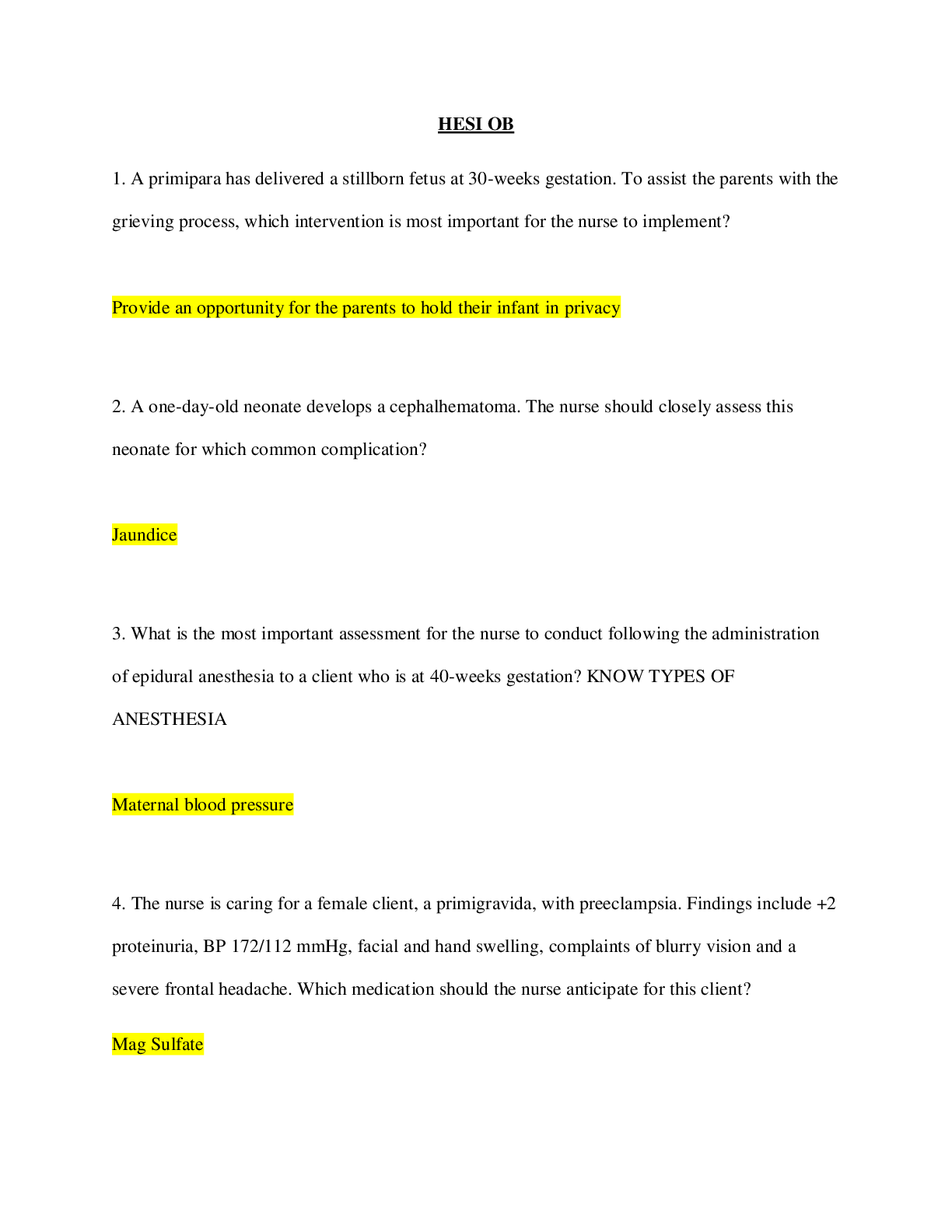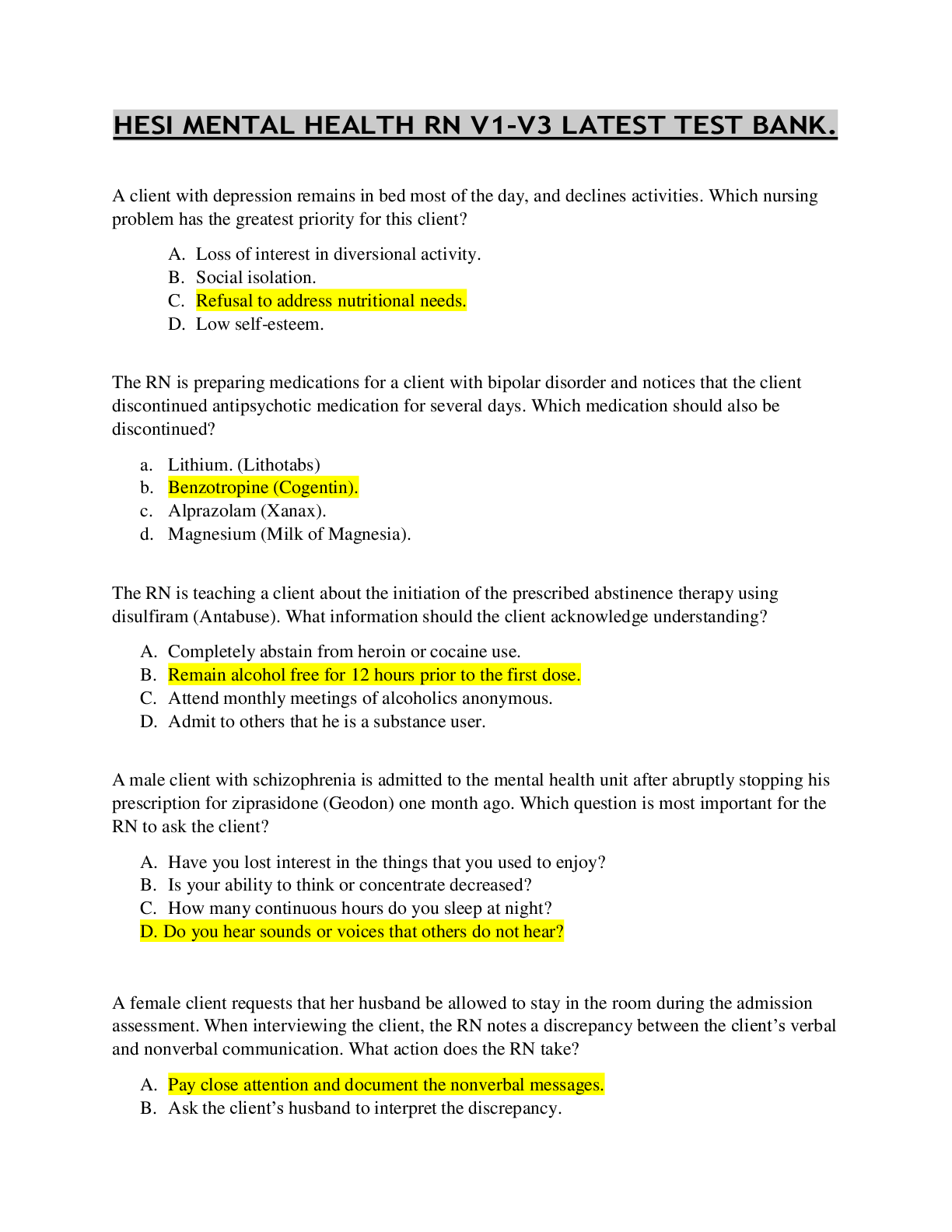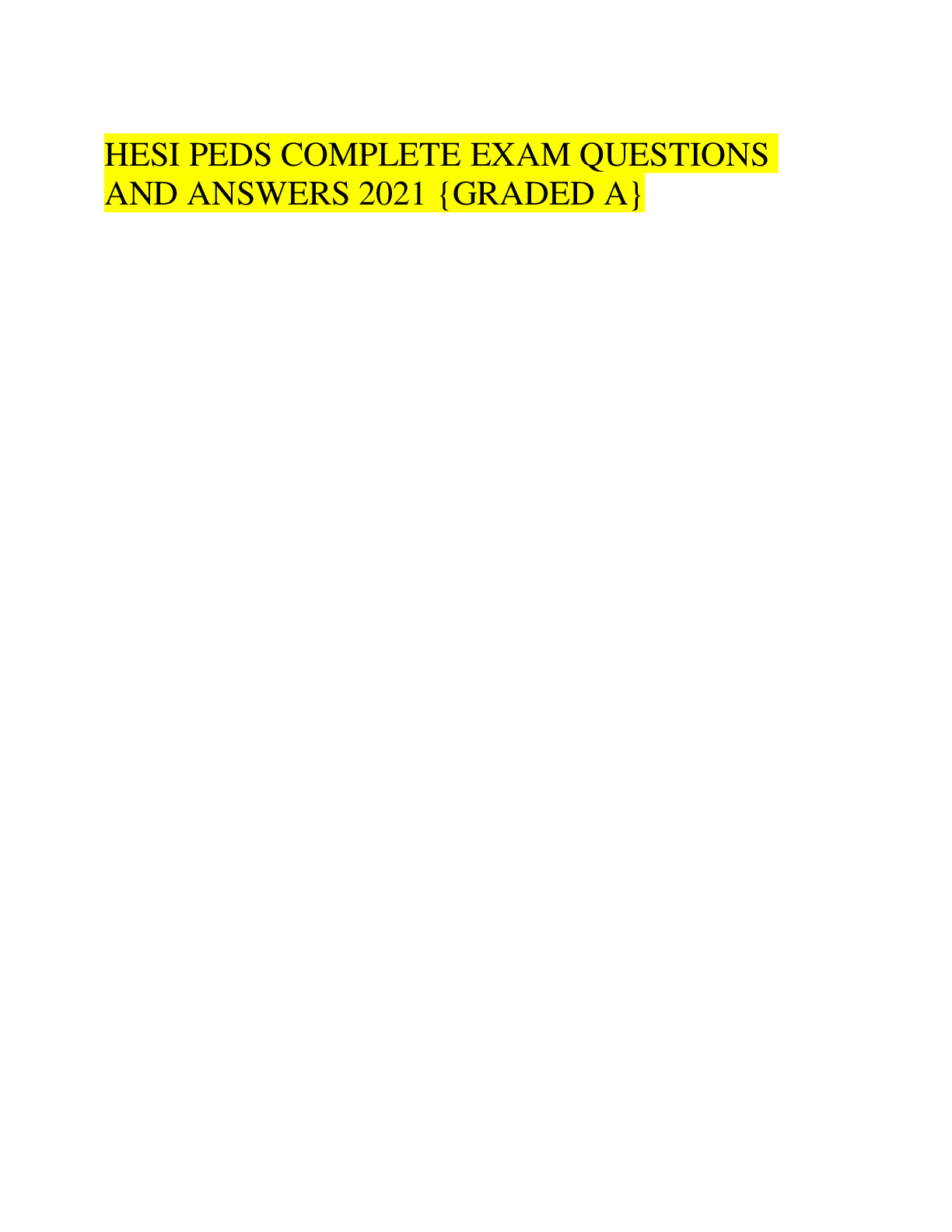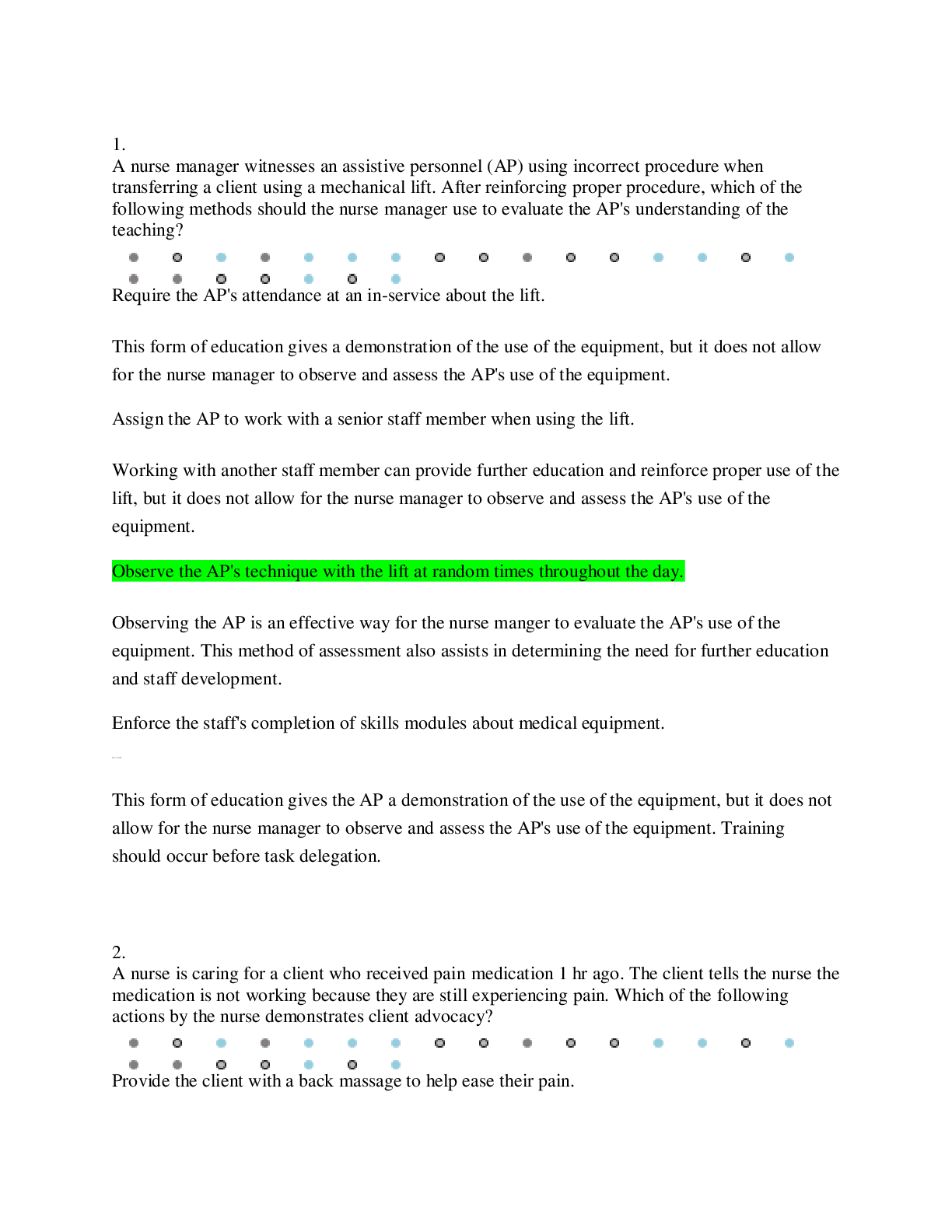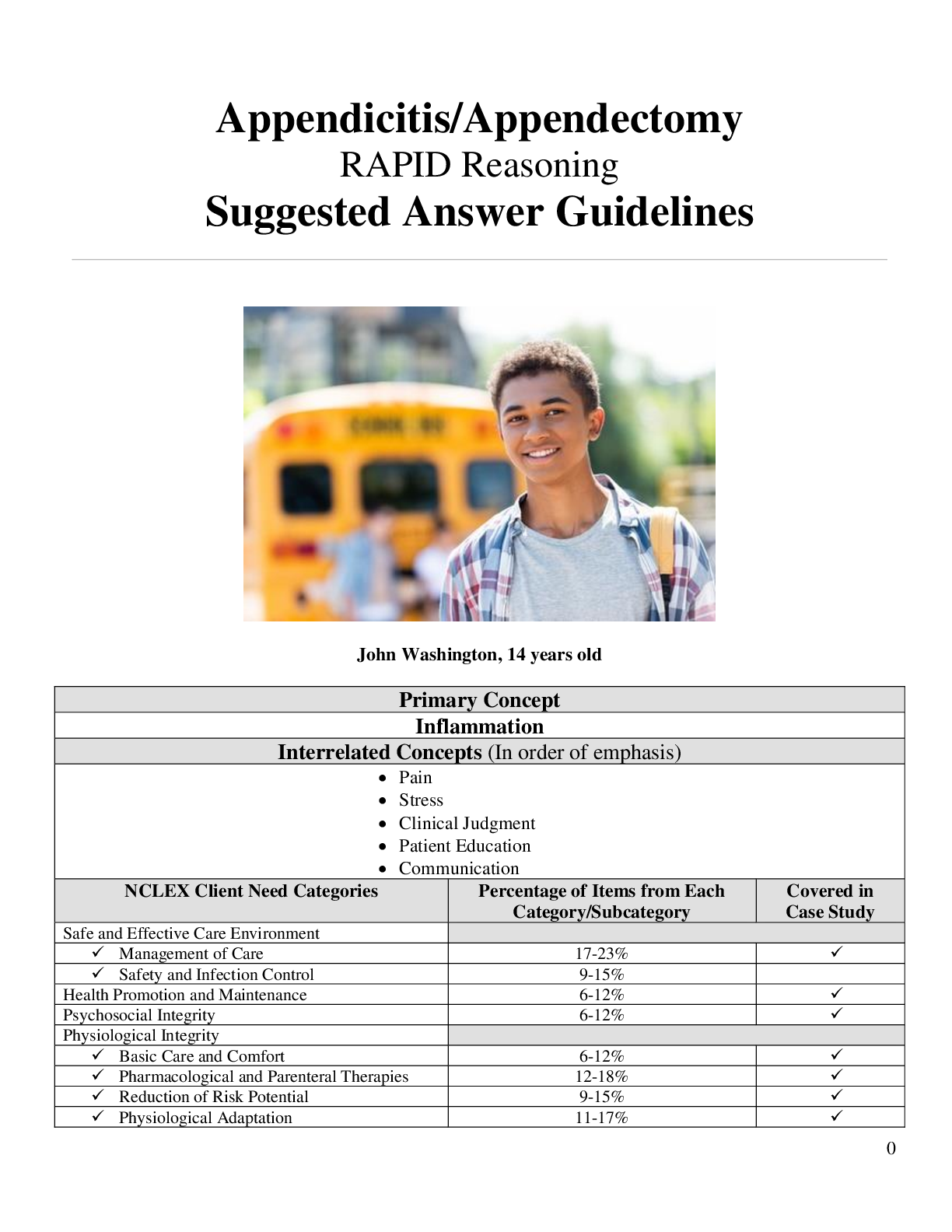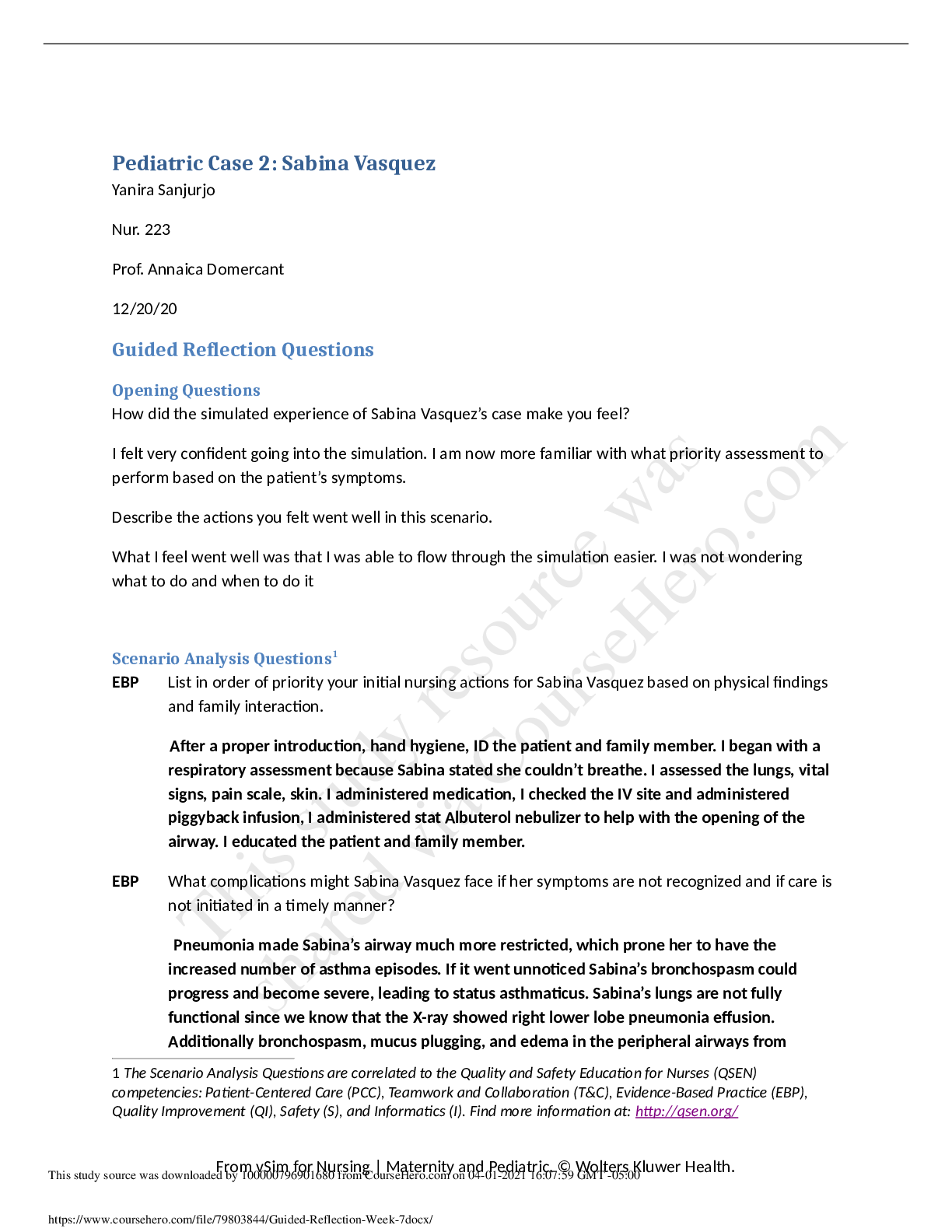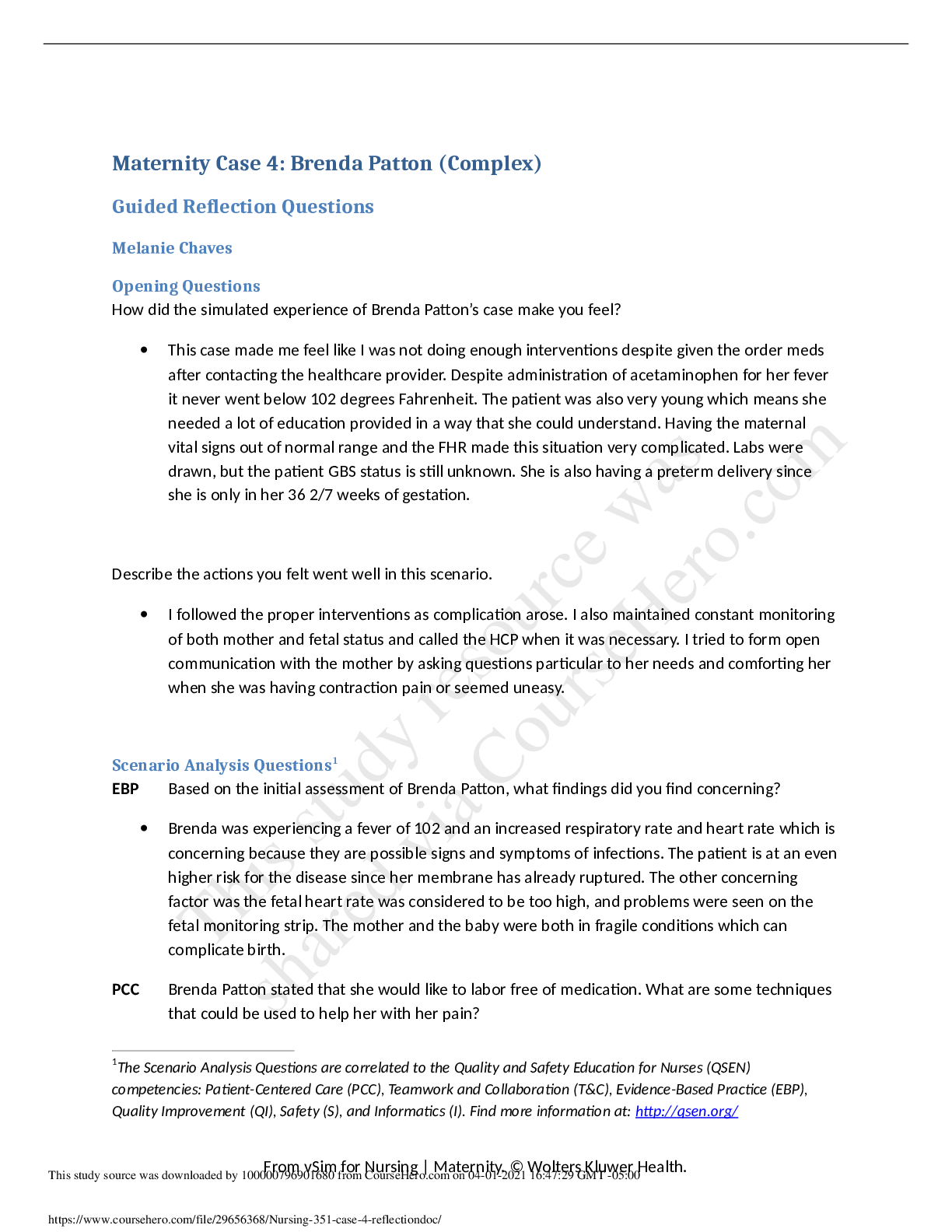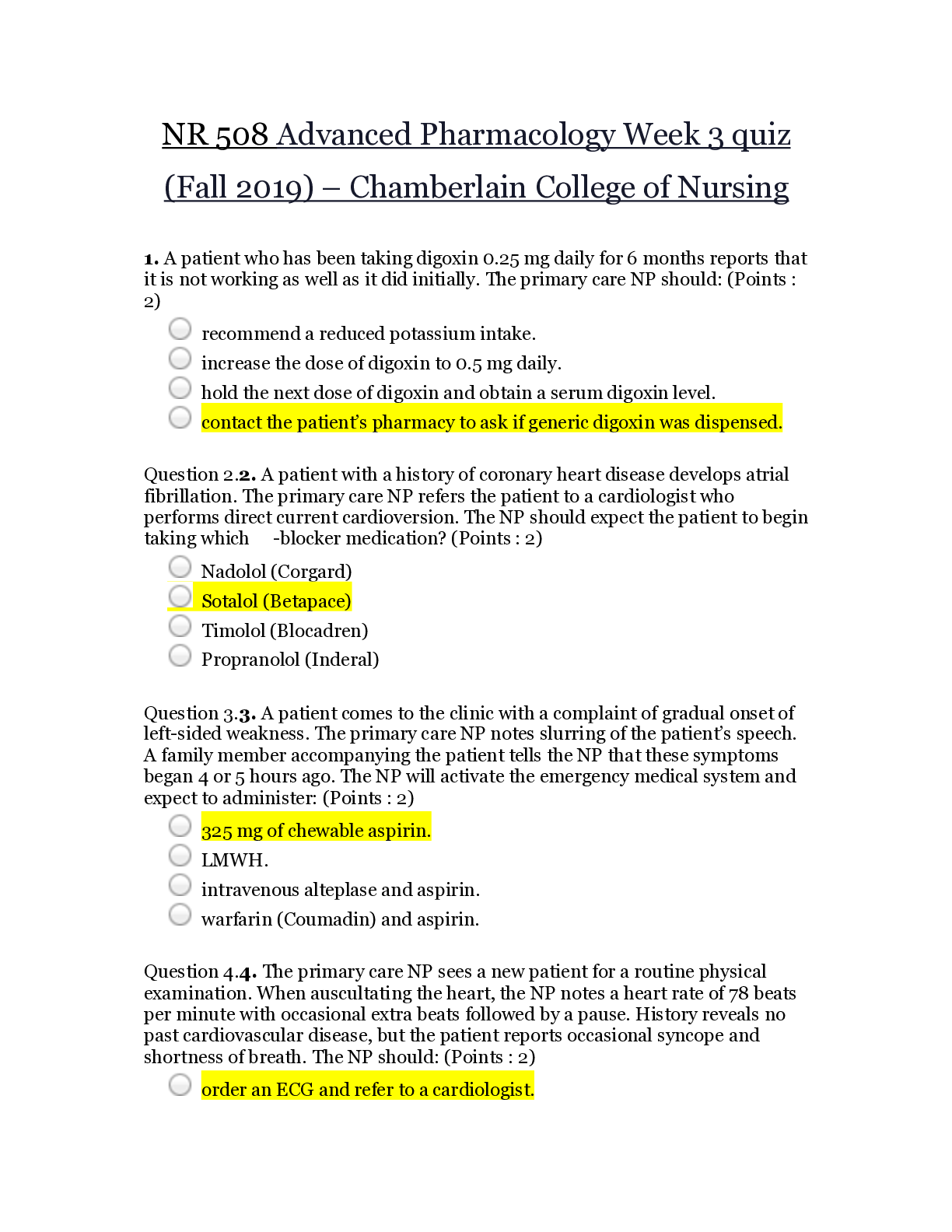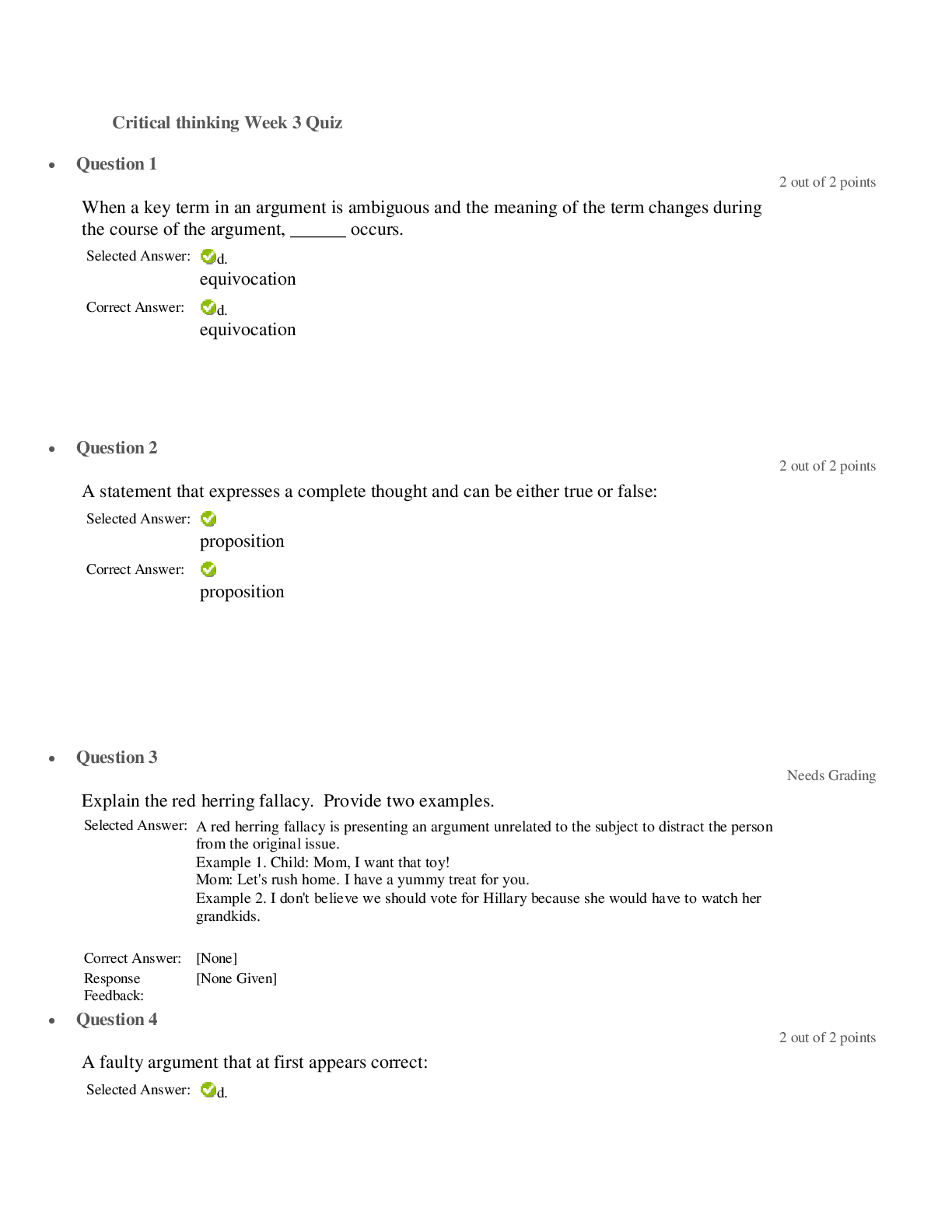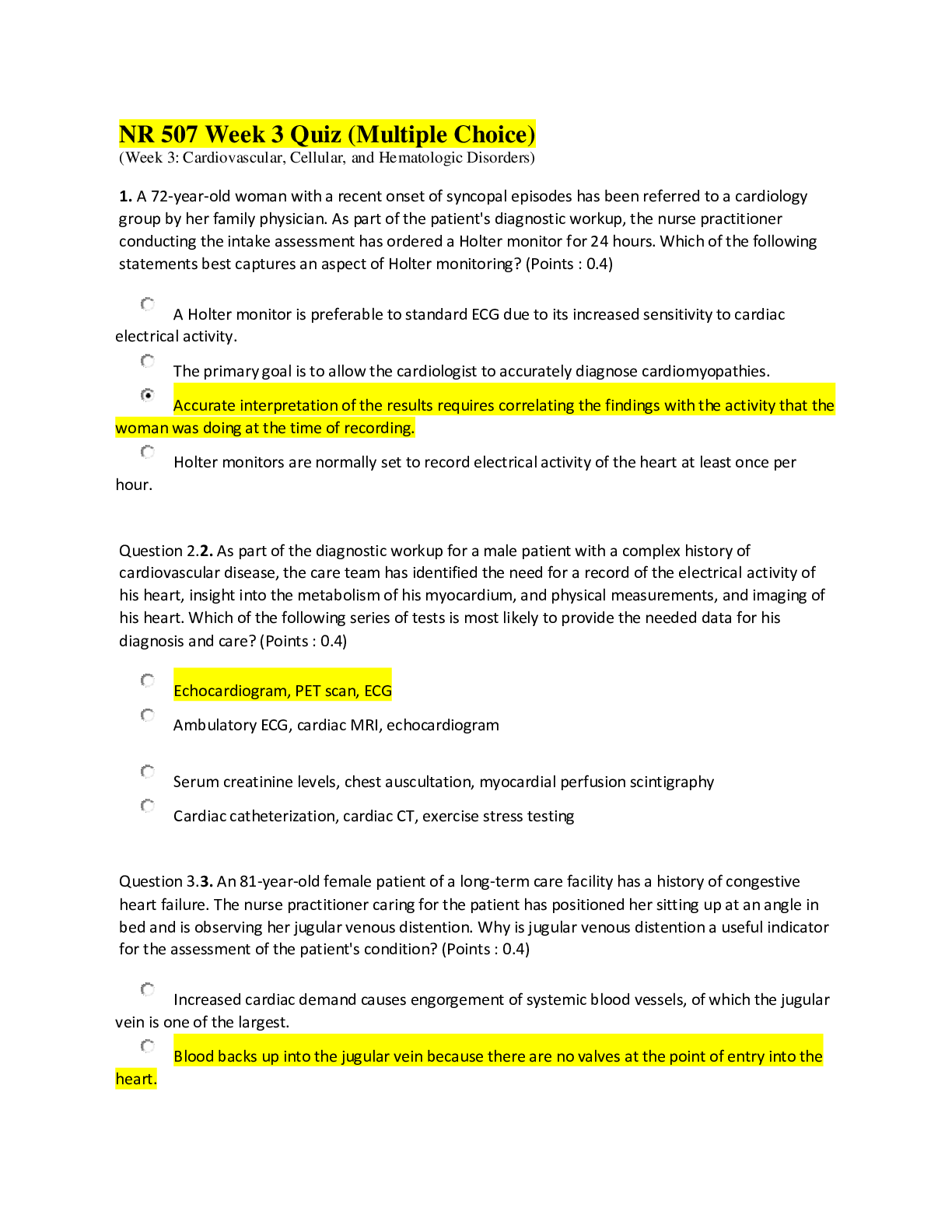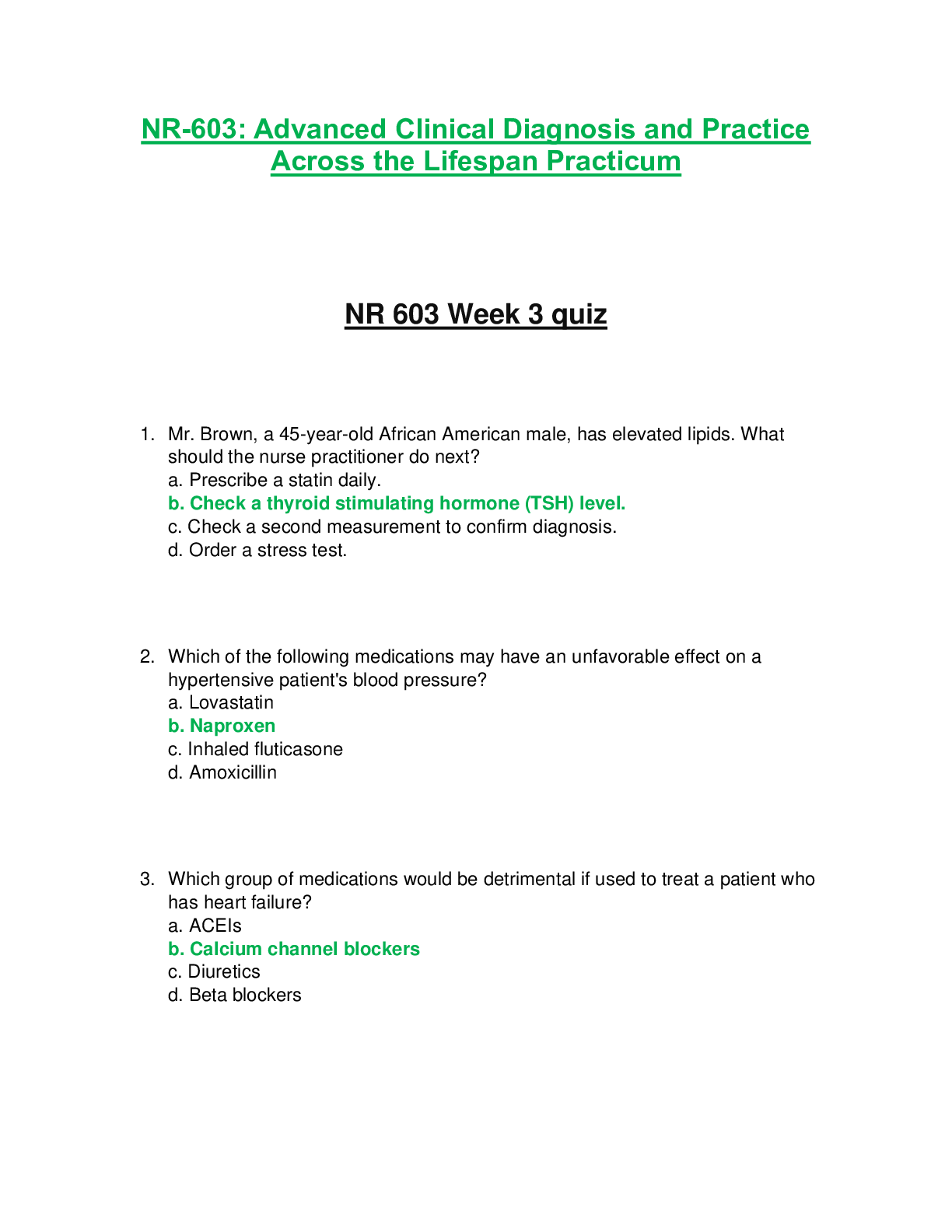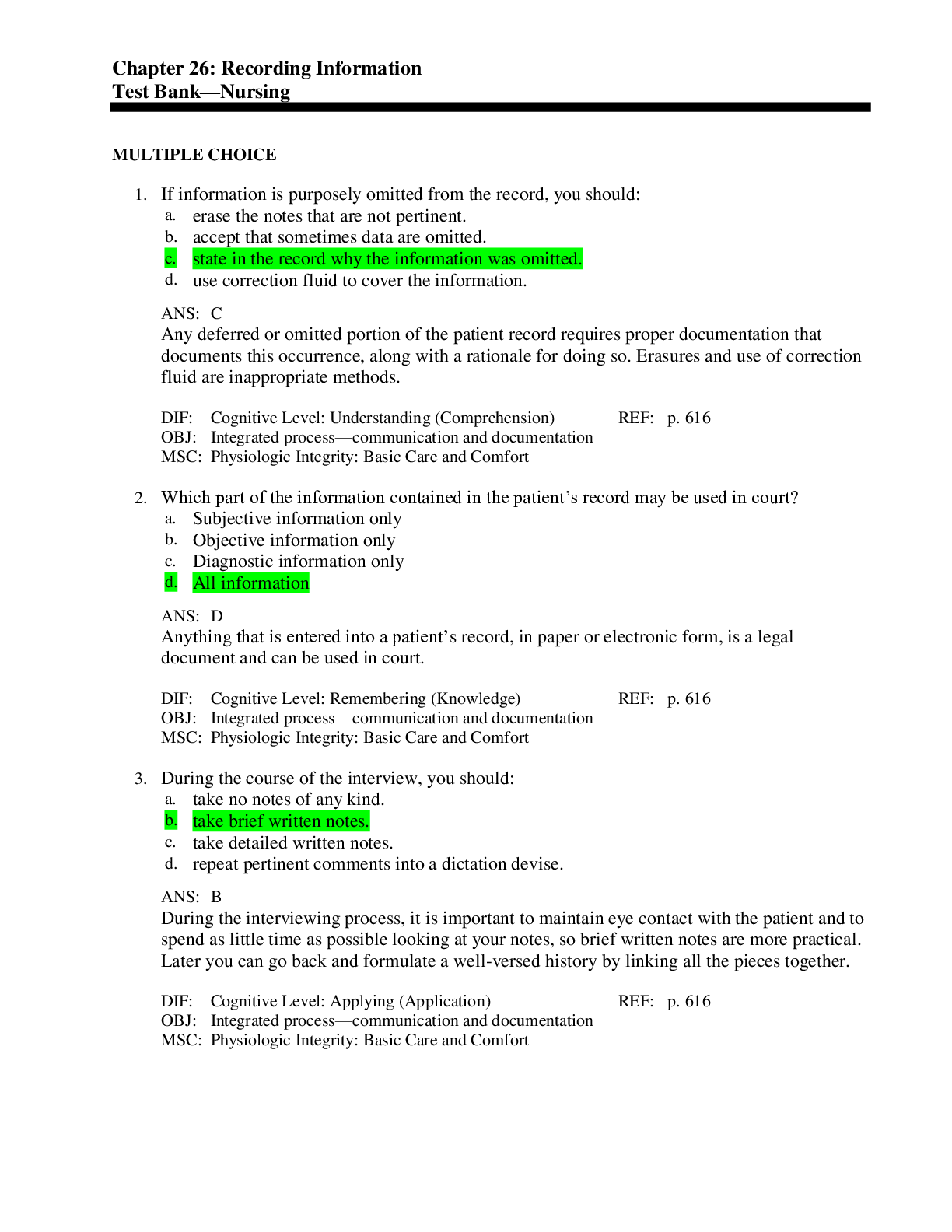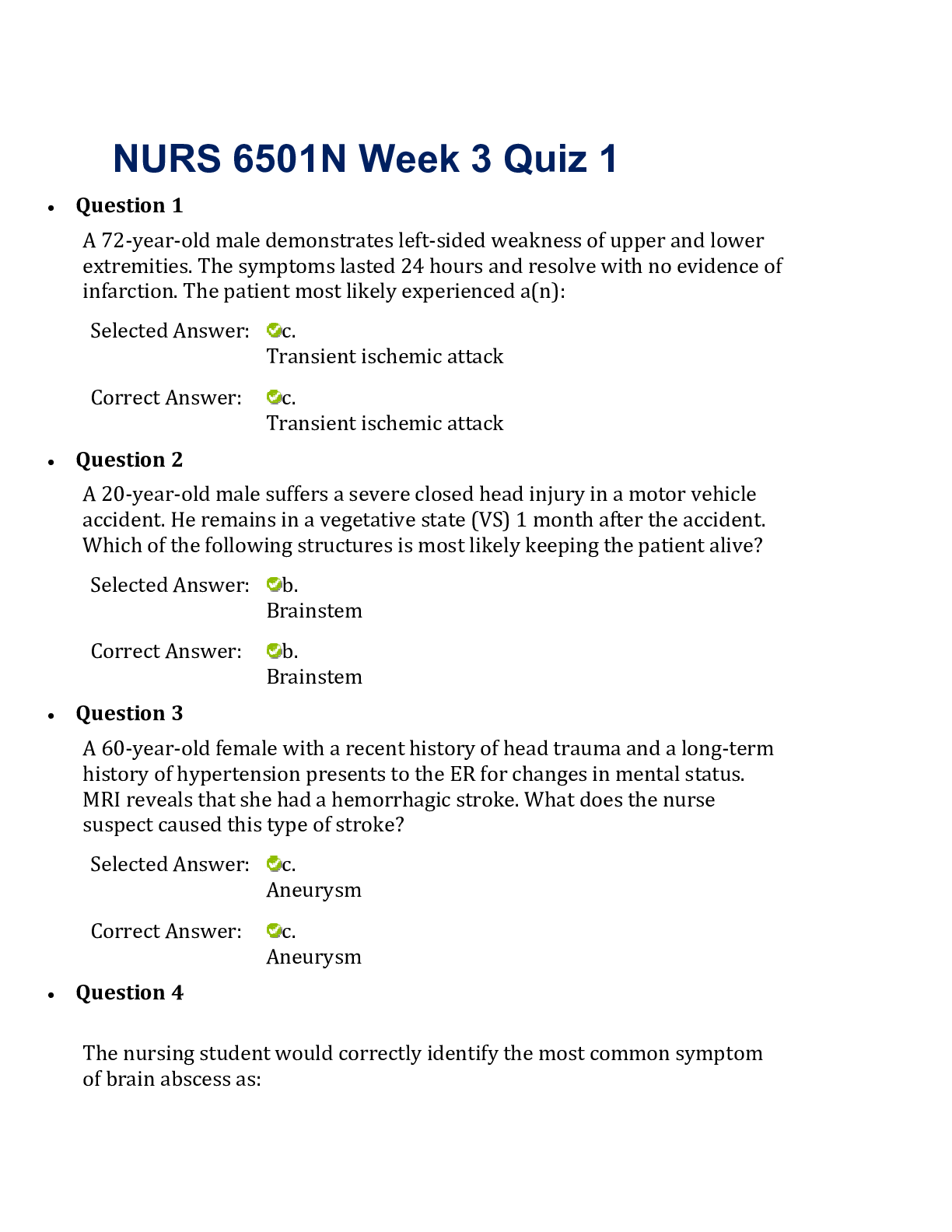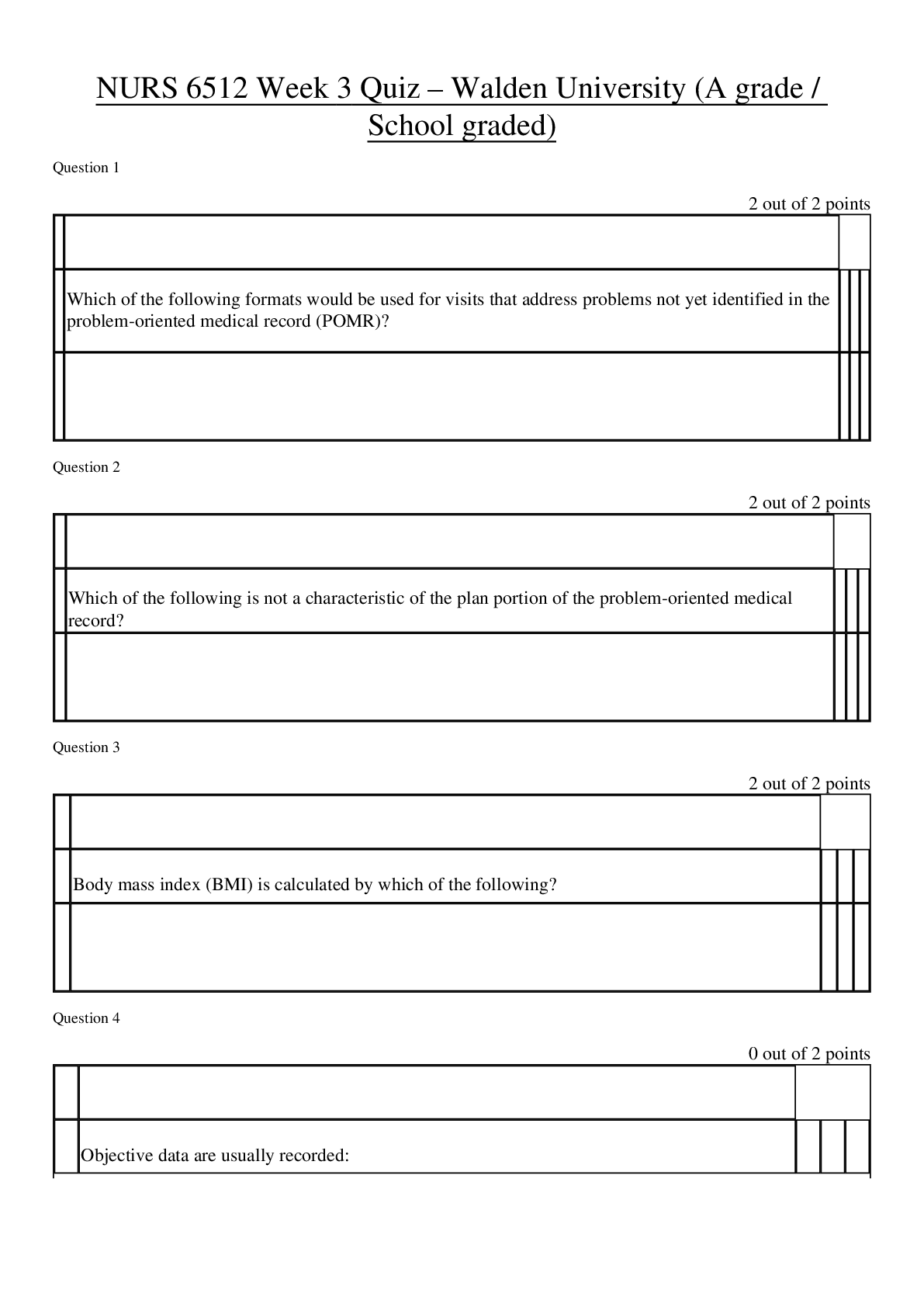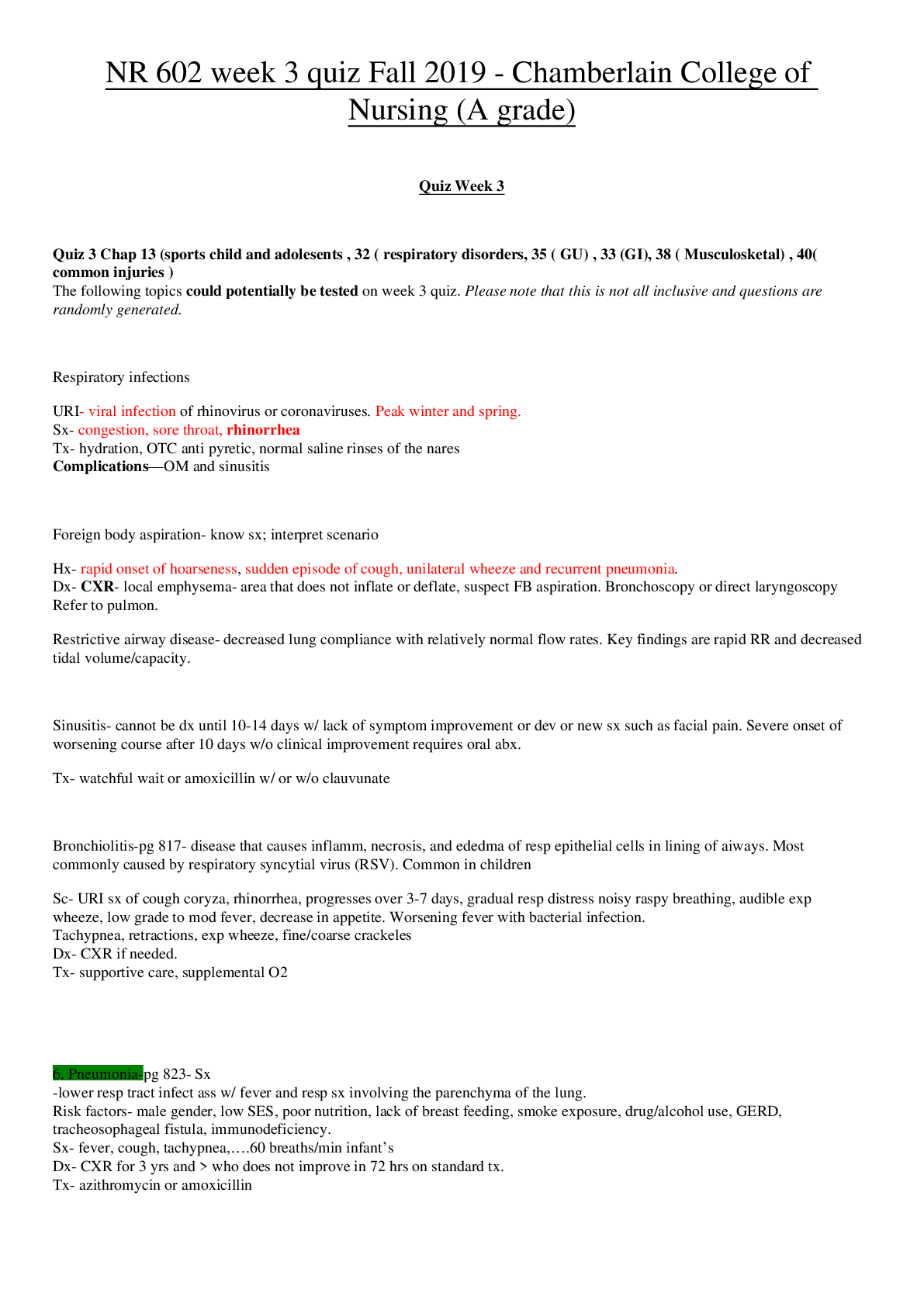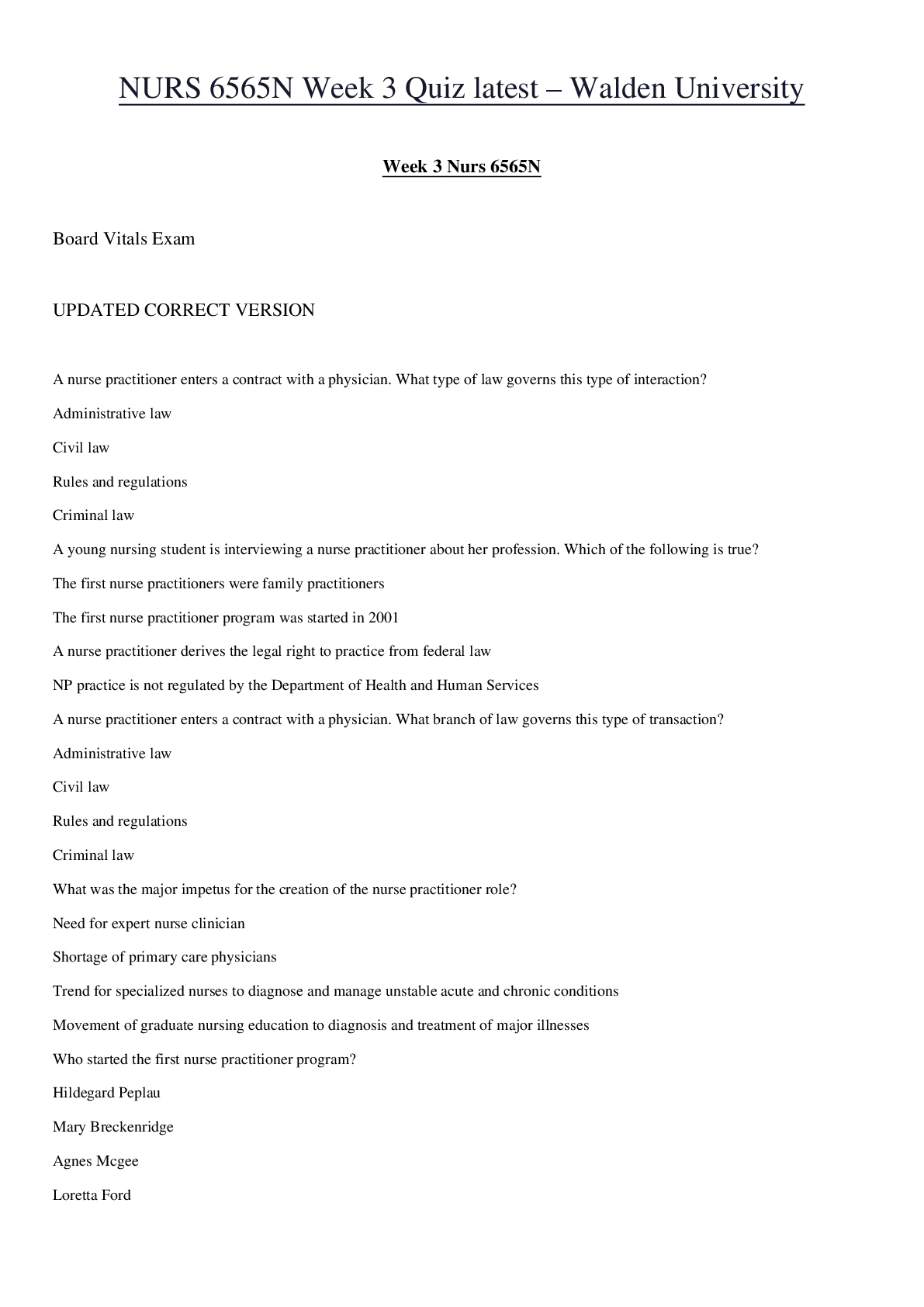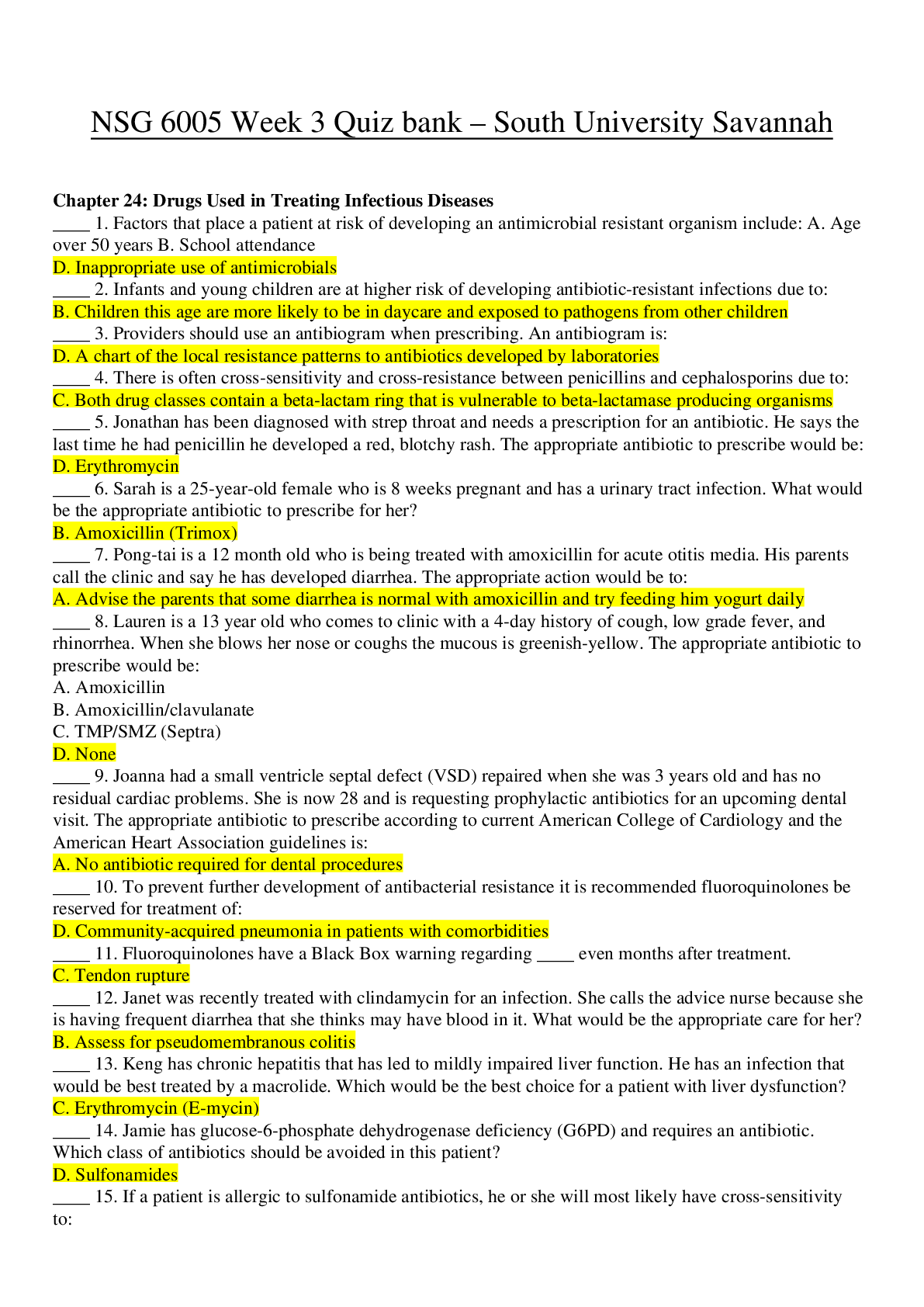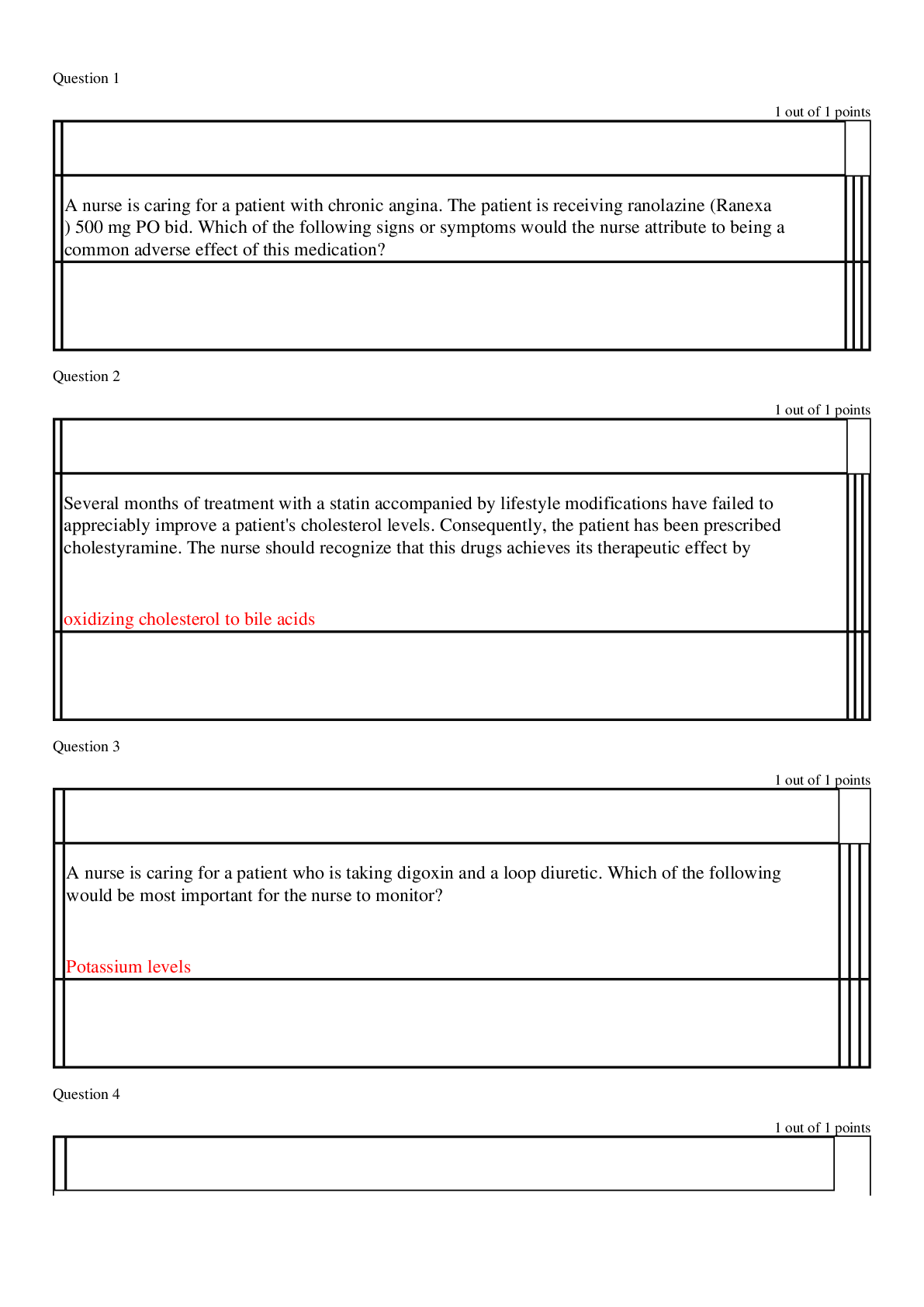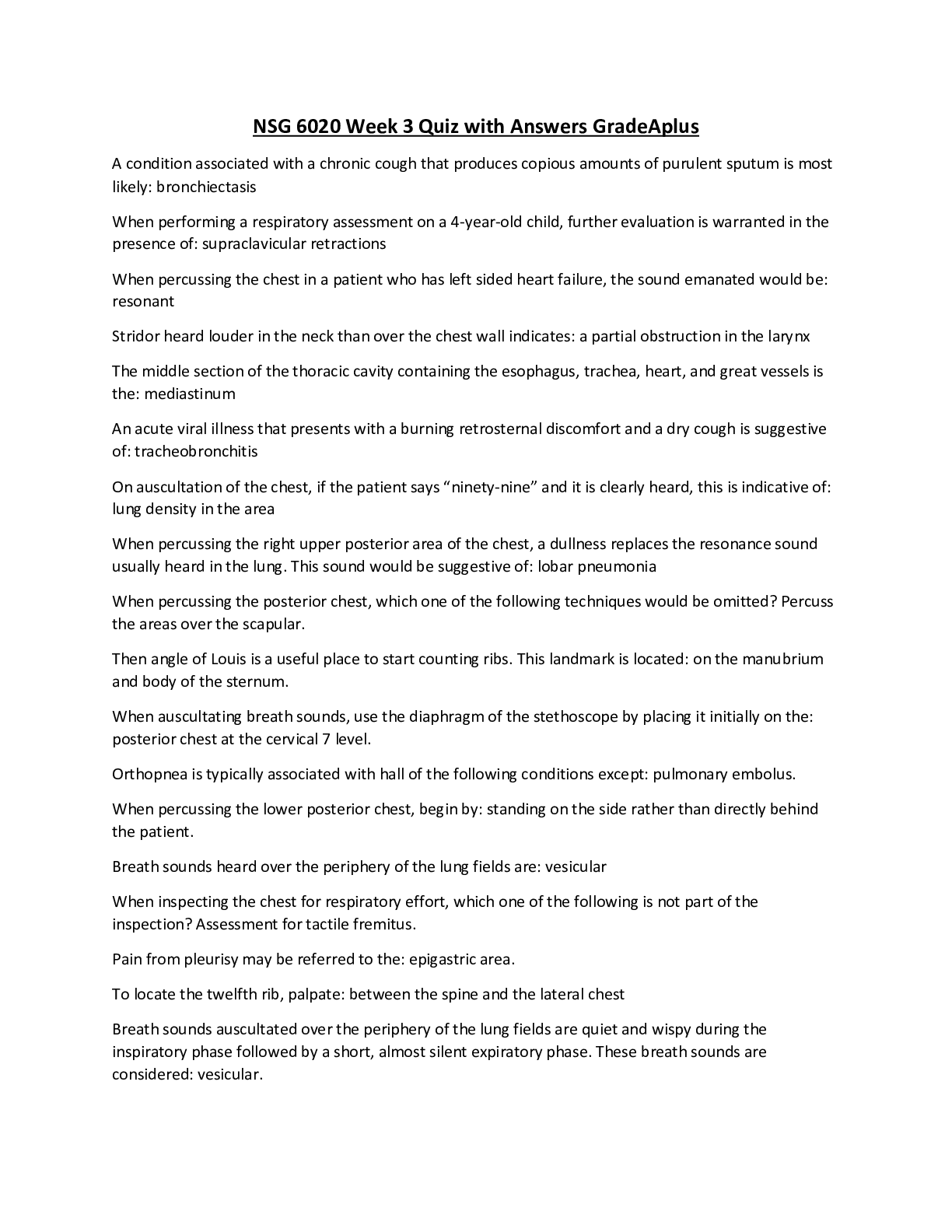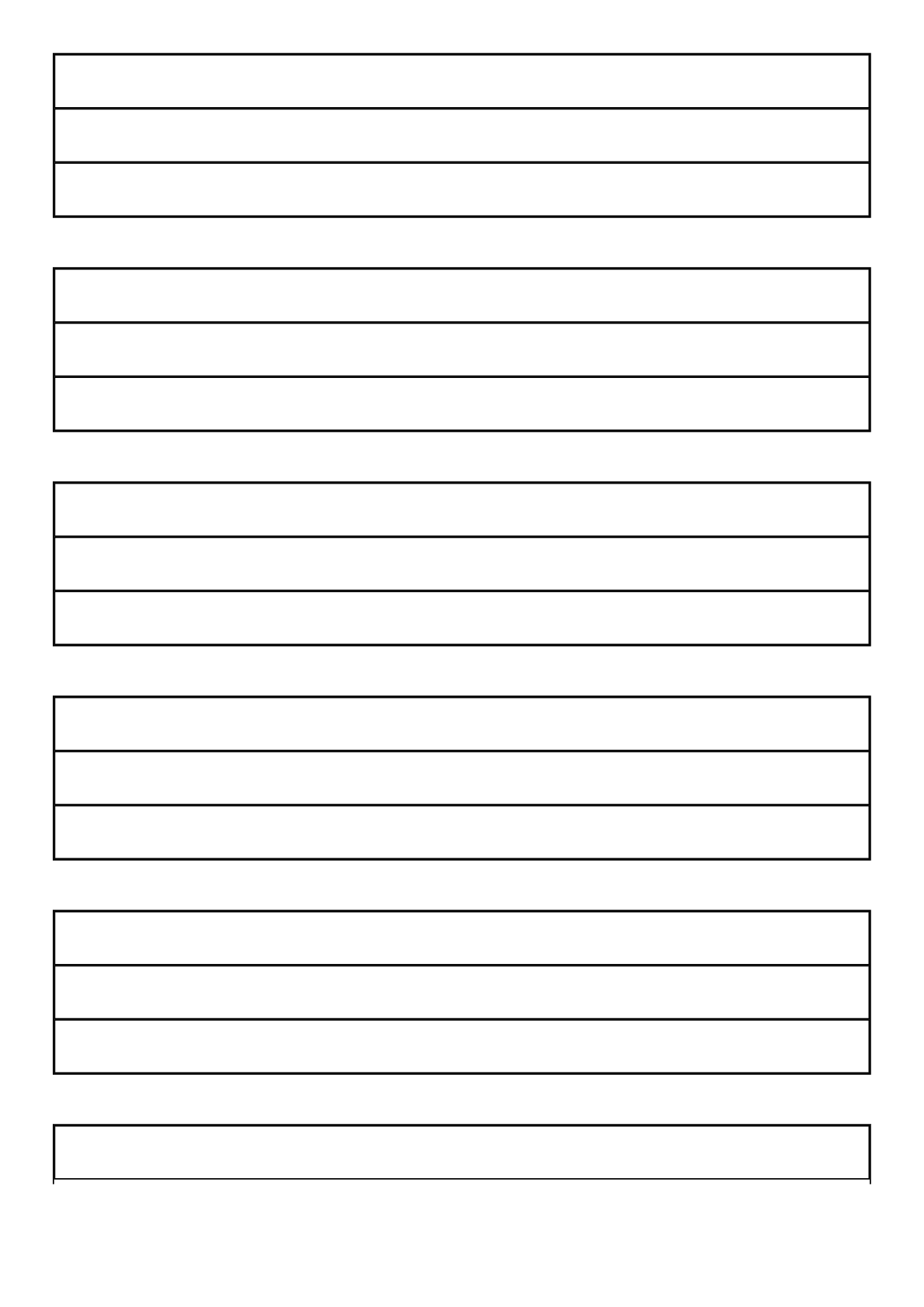NR 509 week 3 quiz 2020(All answers are correctly done and well explained)
Document Content and Description Below
Chapter 22: Musculoskeletal System MULTIPLE CHOICE 1. A patient is being assessed for range-of-joint movement. The nurse asks him to move his arm in toward the center of his body. This movement is ... called: a. Flexion. b. Abduction. c. Adduction. d. Extension. 2. A patient tells the nurse that she is having a hard time bringing her hand to her mouth when she eats or tries to brush her teeth. The nurse knows that for her to move her hand to her mouth, she must perform which movement? a. Flexion b. Abduction c. Adduction d. Extension 3. The functional units of the musculoskeletal system are the: a. Joints. Test Bank: Physical Examination & Health Assessment 7e (Jarvis 2015) 338 b. Bones. c. Muscles. d. Tendons. 4. When reviewing the musculoskeletal system, the nurse recalls that hematopoiesis takes place in the: a. Liver. b. Spleen. c. Kidneys. d. Bone marrow. 5. Fibrous bands running directly from one bone to another that strengthen the joint and help prevent movement in undesirable directions are called: a. Bursa. b. Tendons. c. Cartilage. d. Ligaments. 6. The nurse notices that a woman in an exercise class is unable to jump rope. The nurse is aware that to jump rope, ones shoulder has to be capable of: a. Inversion. b. Supination. c. Protraction. d. Circumduction. 7. The articulation of the mandible and the temporal bone is known as the: a. Intervertebral foramen. b. Condyle of the mandible. c. Temporomandibular joint. d. Zygomatic arch of the temporal bone. 8. To palpate the temporomandibular joint, the nurses fingers should be placed in the depression __________ of the ear. a. Distal to the helix b. Proximal to the helix c. Anterior to the tragus d. Posterior to the tragus 9. Of the 33 vertebrae in the spinal column, there are: a. 5 lumbar. b. 5 thoracic. c. 7 sacral. d. 12 cervical. 10. An imaginary line connecting the highest point on each iliac crest would cross the __________ vertebra. a. First sacral b. Fourth lumbar c. Seventh cervical d. Twelfth thoracic 11. The nurse is explaining to a patient that there are shock absorbers in his back to cushion the spine and to help it move. The nurse is referring to his: a. Vertebral column. b. Nucleus pulposus. c. Vertebral foramen. d. Intervertebral disks. 12. The nurse is providing patient education for a man who has been diagnosed with a rotator cuff injury. The nurse knows that a rotator cuff injury involves the: a. Nucleus pulposus. b. Articular processes. c. Medial epicondyle. d. Glenohumeral joint. 13. During an interview the patient states, I can feel this bump on the top of both of my shoulders it doesn't hurt but I am curious about what it might be. The nurse should tell the patient that it is his: a. Subacromial bursa. b. Acromion process. c. Glenohumeral joint. d. Greater tubercle of the humerus. 14. The nurse is checking the range of motion in a patient's knee and knows that the knee is capable of which movement(s)? a. Flexion and extension b. Supination and pronation c. Circumduction d. Inversion and eversion 15. A patient is visiting the clinic for an evaluation of a swollen, painful knuckle. The nurse notices that the knuckle above his ring on the left hand is swollen and that he is unable to remove his wedding ring. This joint is called the _________ joint. a. Interphalangeal b. Tarsometatarsal c. Metacarpophalangeal d. Tibiotalar *Correction- the MCP is BELOW the ring, but Jarvis doesn’t know that. The CORRECT answer is not listed (PIP). 16. The nurse is assessing a patient's ischial tuberosity. To palpate the ischial tuberosity, the nurse knows that it is best to have the patient: a. Standing. b. Flexing the hip. c. Flexing the knee. d. Lying in the supine position. 17. The nurse is examining the hip area of a patient and palpates a flat depression on the upper, lateral side of the thigh when the patient is standing. The nurse interprets this finding as the: a. Ischial tuberosity. b. Greater trochanter. c. Iliac crest. d. Gluteus maximus muscle. 18. The ankle joint is the articulation of the tibia, fibula, and: a. Talus. b. Cuboid. c. Calcaneus.6h/ d. Cuneiform bones. 19. The nurse is explaining the mechanism of the growth of long bones to a mother of a toddler. Where does lengthening of the bones occur? a. Bursa b. Calcaneus c. Epiphyses d. Tuberosities 20. A woman who is 8 months pregnant comments that she has noticed a change in her posture and is having lower back pain. The nurse tells her that during pregnancy, women have a posture shift to compensate for the enlarging fetus. This shift in posture is known as: a. Lordosis. b. Scoliosis. c. Ankylosis. d. Kyphosis. 21. An 85-year-old patient comments during his annual physical examination that he seems to be getting shorter as he ages. The nurse should explain that decreased height occurs with aging because: a. Long bones tend to shorten with age. b. The vertebral column shortens. c. A significant loss of subcutaneous fat occurs. d. A thickening of the intervertebral disks develops. 22. A patient has been diagnosed with osteoporosis and asks the nurse, What is osteoporosis? The nurse explains that osteoporosis is defined as: a. Increased bone matrix. b. Loss of bone density. c. New, weaker bone growth. d. Increased phagocytic activity. 23. The nurse is teaching a class on preventing osteoporosis to a group of perimenopausal women. Which of these actions is the best way to prevent or delay bone loss in this group? a. Taking calcium and vitamin D supplements b. Taking medications to prevent osteoporosis c. Performing physical activity, such as fast walking d. Assessing bone density annually 24. A teenage girl has arrived complaining of pain in her left wrist. She was playing basketball when she fell and landed on her left hand. The nurse examines her hand and would expect a fracture if the girl complains of a: a. Dull ache. b. Deep pain in her wrist. c. Sharp pain that increases with movement. d. Dull throbbing pain that increases with rest. 25. A patient is complaining of pain in his joints that is worse in the morning, better after he moves around for a while, and then gets worse again if he sits for long periods. The nurse should assess for other signs of what problem? a. Tendinitis b. Osteoarthritis c. Rheumatoid arthritis d. Intermittent claudication 26. A patient states, I can hear a crunching or grating sound when I kneel. She also states that it is very difficult to get out of bed in the morning because of stiffness and pain in my joints. The nurse should assess for signs ofwhat problem? a. Crepitation b. Bone spur c. Loose tendon d. Fluid in the knee joint 27. A patient is able to flex his right arm forward without difficulty or pain but is unable to abduct his arm because of pain and muscle spasms. The nurse should suspect: a. Crepitation. b. Rotator cuff lesions. c. Dislocated shoulder. d. Rheumatoid arthritis. 28. A professional tennis player comes into the clinic complaining of a sore elbow. The nurse will assess for tenderness at the: a. Olecranon bursa. b. Annular ligament. c. Base of the radius. d. Medial and lateral epicondyle. 29. The nurse suspects that a patient has carpal tunnel syndrome and wants to perform the Phalen test. To perform this test, the nurse should instruct the patient to: a. Dorsiflex the foot. b. Plantarflex the foot. c. Hold both hands back to back while flexing the wrists 90 degrees for 60 seconds. d. Hyperextend the wrists with the palmar surface of both hands touching, and wait for 60 seconds. 30. An 80-year-old woman is visiting the clinic for a checkup. She states, I can't walk as much as I used to. The nurse is observing for motor dysfunction in her hip and should ask her to: a. Internally rotate her hip while she is sitting. b. Abduct her hip while she is lying on her back. c. Adduct her hip while she is lying on her back. d. Externally rotate her hip while she is standing. 31. The nurse has completed the musculoskeletal examination of a patient's knee and has found a positive bulge sign. The nurse interprets this finding to indicate: a. Irregular bony margins. b. Soft-tissue swelling in the joint. c. Swelling from fluid in the epicondyle. d. Swelling from fluid in the suprapatellar pouch. 32. During an examination, the nurse asks a patient to bend forward from the waist and notices that the patient has lateral tilting. When his leg is raised straight up, the patient complains of a pain going down his buttock into his leg. The nurse suspects: a. Scoliosis. b. Meniscus tear. c. Herniated nucleus pulposus. d. Spasm of paravertebral muscles. 33. The nurse is examining a 3-month-old infant. While the nurse holds his or her thumbs on the infants inner mid thighs and the fingers on the outside of the infant's hips, touching the greater trochanter, the nurse adducts the legs until the his or her thumbs touch and then abducts the legs until the infants knees touch the table. The nurse does not notice any clunking sounds and is confident to record a: a. Positive Allis test. b. Negative Allis test. c. Positive Ortolani sign. d. Negative Ortolani sign. 34. During a neonatal examination, the nurse notices that the newborn infant has six toes. This finding is documented as: a. Unidactyly. b. Syndactyly. c. Polydactyly. d. Multidactyly. 35. A mother brings her newborn baby boy in for a checkup; she tells the nurse that he does not seem to be moving his right arm as much as his left and that he seems to have pain when she lifts him up under the arms. The nurse suspects a fractured clavicle and would observe for: a. Negative Allis test. b. Positive Ortolani sign. c. Limited range of motion during the Moro reflex. d. Limited range of motion during Lasgue test. 36. A 40-year-old man has come into the clinic with complaints of extreme pain in his toes. The nurse notices that his toes are slightly swollen, reddened, and warm to the touch. His complaints would suggest: a. Osteoporosis. b. Acute gout. c. Ankylosing spondylitis. d. Degenerative joint disease. 37. A young swimmer comes to the sports clinic complaining of a very sore shoulder. He was running at the pool, slipped on some wet concrete, and tried to catch himself with his outstretched hand. He landed on his outstretched hand and has not been able to move his shoulder since. The nurse suspects: a. Joint effusion. b. Tear of rotator cuff. c. Adhesive capsulitis. d. Dislocated shoulder. 38. A 68-year-old woman has come in for an assessment of her rheumatoid arthritis, and the nurse notices raised, firm, nontender nodules at the olecranon bursa and along the ulna. These nodules are most commonly diagnosed as: a. Epicondylitis. b. Gouty arthritis. c. Olecranon bursitis. d. Subcutaneous nodules. 39. A woman who has had rheumatoid arthritis for years is starting to notice that her fingers are drifting to the side. The nurse knows that this condition is commonly referred to as: a. Radial drift. b. Ulnar deviation. c. Swan-neck deformity. d. Dupuytren contracture. 40. A patient who has had rheumatoid arthritis for years comes to the clinic to ask about changes in her fingers. The nurse will assess for signs of what problems? a. Heberden nodes b. Bouchard nodules c. Swan-neck deformities d. Dupuytren contractures 41. A patients annual physical examination reveals a lateral curvature of the thoracic and lumbar segments of his spine; however, this curvature disappears with forward bending. The nurse knows that this abnormality of the spine is called: a. Structural scoliosis. b. Functional scoliosis. c. Herniated nucleus pulposus. d. Dislocated hip. 42. A 14-year-old boy who has been diagnosed with Osgood-Schlatter disease reports painful swelling just below the knee for the past 5 months. Which response by the nurse is appropriate? a. If these symptoms persist, you may need arthroscopic surgery. b. You are experiencing degeneration of your knee, which may not resolve. c. Your disease is due to repeated stress on the patellar tendon. It is usually self-limited, and your symptoms should resolve with rest. d. Increasing your activity and performing knee-strengthening exercises will help decrease the inflammation and maintain mobility in the knee. 43. When assessing muscle strength, the nurse observes that a patient has complete range of motion against gravity with full resistance. What grade of muscle strength should the nurse record using a 0- to 5-point scale? a. 2 b. 3 c. 4 d. 5 44. The nurse is examining a 6-month-old infant and places the infants feet flat on the table and flexes his knees up. The nurse notes that the right knee is significantly lower than the left. Which of these statements is true of this finding? a. This finding is a positive Allis sign and suggests hip dislocation. b. The infant probably has a dislocated patella on the right knee. c. This finding is a negative Allis sign and normal for an infant of this age. d. The infant should return to the clinic in 2 weeks to see if his condition has changed. 45. The nurse is assessing a 1-week-old infant and is testing his muscle strength. The nurse lifts the infant with hands under the axillae and notices that the infant starts to slip between the hands. The nurse should: a. Suspect a fractured clavicle. b. Suspect that the infant may have a deformity of the spine. c. Suspect that the infant may have weakness of the shoulder muscles. d. Conclude that this is a normal finding because the musculature of an infant at this age is undeveloped. 46. The nurse is examining a 2-month-old infant and notices asymmetry of the infants gluteal folds. The nurse should assess for other signs of what disorder? a. Fractured clavicle b. Down syndrome c. Spina bifida d. Hip dislocation 47. The nurse should use which test to check for large amounts of fluid around the patella? a. Ballottement b. Tinel sign c. Phalen test d. McMurray test 48. A patient tells the nurse that, All my life I've been called knock knees. The nurse knows that another term for knock knees is: a. Genu varum. b. Genu valgum. c. Pesplanus. d. Metatarsus adductus. 49. A man who has had gout for several years comes to the clinic with a problem with his toe. On examination, the nurse notices the presence of hard, painless nodules over the great toe; one has burst open with a chalky discharge. This finding is known as: a. Callus. b. Plantar wart. c. Bunion. d. Tophi. 50. When performing a musculoskeletal assessment, the nurse knows that the correct approach for the examination should be: a. Proximal to distal. b. Distal to proximal. c. Posterior to anterior. d. Anterior to posterior. MULTIPLE RESPONSE 1. The nurse is assessing the joints of a woman who has stated, I have a long family history of arthritis, and my joints hurt. The nurse suspects that she has osteoarthritis. Which of these are symptoms of osteoarthritis? Select all that apply. a. Symmetric joint involvement b. Asymmetric joint involvement c. Pain with motion of affected joints d. Affected joints are swollen with hard, bony protuberances e. Affected joints may have heat, redness, and swelling Chapter 23: Neurologic System MULTIPLE CHOICE 1. The two parts of the nervous system are the: a. Motor and sensory. b. Central and peripheral. c. Peripheral and autonomic. d. Hypothalamus and cerebral. 2. The wife of a 65-year-old man tells the nurse that she is concerned because she has noticed a change in her husband's personality and ability to understand. He also cries very easily and becomes angry. The nurse recalls that the cerebral lobe responsible for these behaviors is the __________ lobe. a. Frontal b. Parietal c. Occipital d. Temporal 3. Which statement concerning the areas of the brain is true? a. The cerebellum is the center for speech and emotions. b. The hypothalamus controls body temperature and regulates sleep. c. The basal ganglia are responsible for controlling voluntary movements. d. Motor pathways of the spinal cord and brainstem synapse in the thalamus. 4. The area of the nervous system that is responsible for mediating reflexes is the: a. Medulla. b. Cerebellum. c. Spinal cord. d. Cerebral cortex. 5. While gathering equipment after an injection, a nurse accidentally received a prick from an improperly capped needle. To interpret this sensation, which of these areas must be intact? a. Corticospinal tract, medulla, and basal ganglia b. Pyramidal tract, hypothalamus, and sensory cortex c. Lateral spinothalamic tract, thalamus, and sensory cortex d. Anterior spinothalamic tract, basal ganglia, and sensory cortex 6. A patient with a lack of oxygen to his heart will have pain in his chest and possibly in the shoulder, arms, or jaw. The nurse knows that the best explanation why this occurs is which one of these statements? a. A problem exists with the sensory cortex and its ability to discriminate the location. b. The lack of oxygen in his heart has resulted in decreased amount of oxygen to the areas experiencing the pain. c. The sensory cortex does not have the ability to localize pain in the heart; consequently, the pain is felt elsewhere. d. A lesion has developed in the dorsal root, which is preventing the sensation from being transmitted normally. 7. The ability that humans have to perform very skilled movements such as writing is controlled by the: a. Basal ganglia. b. Corticospinal tract. c. Spinothalamic tract. d. Extrapyramidal tract. 8. A 30-year-old woman tells the nurse that she has been very unsteady and has had difficulty in maintaining her balance. Which area of the brain that is related to these findings would concern the nurse? a. Thalamus b. Brainstem c. Cerebellum d. Extrapyramidal tract 9. Which of these statements about the peripheral nervous system is correct? a. The CNs enter the brain through the spinal cord. b. Efferent fibers carry sensory input to the central nervous system through the spinal cord. c. The peripheral nerves are inside the central nervous system and carry impulses through their motor fibers. d. The peripheral nerves carry input to the central nervous system by afferent fibers and away from the central nervous system by efferent fibers. 10. A patient has a severed spinal nerve as a result of trauma. Which statement is true in this situation? a. Because there are 31 pairs of spinal nerves, no effect results if only one nerve is severed. b. The dermatome served by this nerve will no longer experience any sensation. c. The adjacent spinal nerves will continue to carry sensations for the dermatome served by the severed nerve. d. A severed spinal nerve will only affect motor function of the patient because spinal nerves have no sensory component. 11. A 21-year-old patient has a head injury resulting from trauma and is unconscious. There are no other injuries. During the assessment what would the nurse expect to find when testing the patients deep tendon reflexes? a. Reflexes will be normal. b. Reflexes cannot be elicited. c. All reflexes will be diminished but present. d. Some reflexes will be present, depending on the area of injury. 12. A mother of a 1-month-old infant asks the nurse why it takes so long for infants to learn to roll over. The nurse knows that the reason for this is: a. A demyelinating process must be occurring with her infant. b. Myelin is needed to conduct the impulses, and the neurons of a newborn are not yet myelinated. c. The cerebral cortex is not fully developed; therefore, control over motor function gradually occurs. d. The spinal cord is controlling the movement because the cerebellum is not yet fully developed. 13. During an assessment of an 80-year-old patient, the nurse notices the following: an inability to identify vibrations at her ankle and to identify the position of her big toe, a slower and more deliberate gait, and a slightly impaired tactile sensation. All other neurologic findings are normal. The nurse should interpret that these findings indicate: a. CN dysfunction. b. Lesion in the cerebral cortex. c. Normal changes attributable to aging. d. Demyelination of nerves attributable to a lesion. 14. A 70-year-old woman tells the nurse that every time she gets up in the morning or after shes been sitting, she gets really dizzy and feels like she is going to fall over. The nurse's best response would be: a. Have you been extremely tired lately? b. You probably just need to drink more liquids. c. I'll refer you for a complete neurologic examination. d. You need to get up slowly when youve been lying down or sitting. 15. During the taking of the health history, a patient tells the nurse that it feels like the room is spinning around me. The nurse would document this finding as: a. Vertigo. b. Syncope. c. Dizziness. d. Seizure activity. 16. When taking the health history on a patient with a seizure disorder, the nurse assesses whether the patient has an aura. Which of these would be the best question for obtaining this information? a. Does your muscle tone seem tense or limp? b. After the seizure, do you spend a lot of time sleeping? c. Do you have any warning sign before your seizure starts? d. Do you experience any color change or incontinence during the seizure? 17. While obtaining a health history of a 3-month-old infant from the mother, the nurse asks about the infant's ability to suck and grasp the mothers finger. What is the nurse assessing? a. Reflexes b. Intelligence c. CNs d. Cerebral cortex function 18. In obtaining a health history on a 74-year-old patient, the nurse notes that he drinks alcohol daily and that he has noticed a tremor in his hands that affects his ability to hold things. With this information, what response should the nurse make? a. Does your family know you are drinking every day? b. Does the tremor change when you drink alcohol? c. We'll do some tests to see what is causing the tremor. d. You really shouldn't drink so much alcohol; it may be causing your tremor. 19. A 50-year-old woman is in the clinic for weakness in her left arm and leg that she has noticed for the past week. The nurse should perform which type of neurologic examination? a. Glasgow Coma Scale b. Neurologic recheck examination c. Screening neurologic examination d. Complete neurologic examination 20. During an assessment of the CNs, the nurse finds the following: asymmetry when the patient smiles or frowns, uneven lifting of the eyebrows, sagging of the lower eyelids, and escape of air when the nurse presses against the right puffed cheek. This would indicate dysfunction of which of these CNs? a. Motor component of CN IV b. Motor component of CN VII c. Motor and sensory components of CN XI d. Motor component of CN X and sensory component of CN VII 21. The nurse is testing the function of CN XI. Which statement best describes the response the nurse should expect if this nerve is intact? The patient: a. Demonstrates the ability to hear normal conversation. b. Sticks out the tongue midline without tremors or deviation. c. Follows an object with his or her eyes without nystagmus or strabismus. d. Moves the head and shoulders against resistance with equal strength. 22. During the neurologic assessment of a healthy 35-year-old patient, the nurse asks him to relax his muscles completely. The nurse then moves each extremity through full range of motion. Which of these results would the nurse expect to find? a. Firm, rigid resistance to movement b. Mild, even resistance to movement c. Hypotonic muscles as a result of total relaxation d. Slight pain with some directions of movement 23. When the nurse asks a 68-year-old patient to stand with his feet together and arms at his side with his eyes closed, he starts to sway and moves his feet farther apart. The nurse would document this finding as: a. Ataxia. b. Lack of coordination. c. Negative Homans sign. d. Positive Romberg sign. 24. The nurse is performing an assessment on a 29-year-old woman who visits the clinic complaining of always dropping things and falling down. While testing rapid alternating movements, the nurse notices that the woman is unable to pat both of her knees. Her response is extremely slow and she frequently misses. What should the nurse suspect? a. Vestibular disease b. Lesion of CN IX c. Dysfunction of the cerebellum d. Inability to understand directions 25. During the taking of the health history of a 78-year-old man, his wife states that he occasionally has problems with short-term memory loss and confusion: He can't even remember how to button his shirt. When assessing his sensory system, which action by the nurse is most appropriate? a. The nurse would not test the sensory system as part of the examination because the results would not be valid. b. The nurse would perform the tests, knowing that mental status does not affect sensory ability. c. The nurse would proceed with an explanation of each test, making certain that the wife understands. d. Before testing, the nurse would assess the patient's mental status and ability to follow directions. 26. The assessment of a 60-year-old patient has taken longer than anticipated. In testing his pain perception, the nurse decides to complete the test as quickly as possible. When the nurse applies the sharp point of the pin on his arm several times, he is only able to identify these as one very sharp prick. What would be the most accurate explanation for this? a. The patient has hyperesthesia as a result of the aging process. b. This response is most likely the result of the summation effect. c. The nurse was probably not poking hard enough with the pin in the other areas. d. The patient most likely has analgesia in some areas of arm and hyperalgesia in others. 27. The nurse is performing a neurologic assessment on a 41-year-old woman with a history of diabetes. When testing her ability to feel the vibrations of a tuning fork, the nurse notices that the patient is unable to feel vibrations on the great toe or ankle bilaterally, but she is able to feel vibrations on both patellae. Given this information, what would the nurse suspect? a. Hyperalgesia b. Hyperesthesia c. Peripheral neuropathy d. Lesion of sensory cortex ANS: Loss of vibration sense occurs with peripheral neuropathy (e.g., diabetes and alcoholism). Peripheral neuropathy is worse at the feet and gradually improves as the examiner moves up the leg, as opposed to a specific nerve lesion, which has a clear zone of deficit for its dermatome. 28. The nurse places a key in the hand of a patient and he identifies it as a penny. What term would the nurse use to describe this finding? a. Extinction b.Astereognosis c. Graphesthesia d. Tactile discrimination 29. The nurse is testing the deep tendon reflexes of a 30-year-old woman who is in the clinic for an annual physical examination. When striking the Achilles heel and quadriceps muscle, the nurse is unable to elicit a reflex. The nurses next response should be to: a. Ask the patient to lock her fingers and pull. b. Complete the examination, and then test these reflexes again. c. Refer the patient to a specialist for further testing. d. Document these reflexes as 0 on a scale of 0 to 4+. ANS: Sometimes the reflex response fails to appear. Documenting the reflexes as absent is inappropriate this soon in the examination. Encourage relaxation, varying the person's position or increasing the strength of the blow. Reinforcement is another technique to relax the muscles and enhance the response. The person should be asked to perform an isometric exercise in a muscle group somewhat away from the one being tested. For example, to enhance a patellar reflex, the person should be asked to lock the fingers together and pull. 30. In assessing a 70-year-old patient who has had a recent cerebrovascular accident, the nurse notices right- sided weakness. What might the nurse expect to find when testing his reflexes on the right side? a. Lack of reflexes b. Normal reflexes c. Diminished reflexes d. Hyperactive reflexes 31. When the nurse is testing the triceps reflex, what is the expected response? a. Flexion of the hand b. Pronation of the hand c. Extension of the forearm d. Flexion of the forearm 32. The nurse is testing superficial reflexes on an adult patient. When stroking up the lateral side of the sole and across the ball of the foot, the nurse notices the plantar flexion of the toes. How should the nurse document this finding? a. Positive Babinski sign b. Plantar reflex abnormal c. Plantar reflex present d. Plantar reflex 2+ on a scale from 0 to 4+ 33. In the assessment of a 1-month-old infant, the nurse notices a lack of response to noise or stimulation. The mother reports that in the last week he has been sleeping all of the time, and when he is awake all he does is cry. The nurse hears that the infants cries are very high pitched and shrill. What should be the nurse's appropriate response to these findings? a. Refer the infant for further testing. b. Talk with the mother about eating habits. c. Do nothing; these are expected findings for an infant this age. d. Tell the mother to bring the baby back in 1 week for a recheck. 34. Which of these tests would the nurse use to check the motor coordination of an 11-month-old infant? a. Denver II b. Stereognosis c. Deep tendon reflexes d. Rapid alternating movements 35. To assess the head control of a 4-month-old infant, the nurse lifts up the infant in a prone position while supporting his chest. The nurse looks for what normal response? The infant: a. Raises the head, and arches the back. b. Extends the arms, and drops down the head. c. Flexes the knees and elbows with the back straight. d. Holds the head at 45 degrees, and keeps the back straight. 36. While assessing a 7-month-old infant, the nurse makes a loud noise and notices the following response: abduction and flexion of the arms and legs; fanning of the fingers, and curling of the index finger and thumb in a C position, followed by the infant bringing in the arms and legs to the body. What does the nurse know about this response? a. This response could indicate brachial nerve palsy. b. This reaction is an expected startle response at this age. c. This reflex should have disappeared between 1 and 4 months of age. d. This response is normal as long as the movements are bilaterally symmetric. 37. To test for gross motor skill and coordination of a 6-year-old child, which of these techniques would be appropriate? Ask the child to: a. Hop on one foot. b. Stand on his head. c. Touch his finger to his nose. d. Make funny faces at the nurse. 38. During the assessment of an 80-year-old patient, the nurse notices that his hands show tremors when he reaches for something and his head is always nodding. No associated rigidity is observed with movement. Which of these statements is most accurate? a. These findings are normal, resulting from aging. b. These findings could be related to hyperthyroidism. c. These findings are the result of Parkinson disease. d. This patient should be evaluated for a cerebellar lesion. ANS: Senile tremors occasionally occur. These benign tremors include an intention tremor of the hands, head nodding (as if saying yes or no), and tongue protrusion. Tremors associated with Parkinson disease include rigidity, slowness, and a weakness of voluntary movement. 39. While the nurse is taking the history of a 68-year-old patient who sustained a head injury 3 days earlier, he tells the nurse that he is on a cruise ship and is 30 years old. The nurse knows that this finding is indicative of a(n): a. Great sense of humor. b. Uncooperative behavior. c. Inability to understand questions. d. Decreased level of consciousness. 40. The nurse is caring for a patient who has just had neurosurgery. To assess for increased intracranial pressure, what would the nurse include in the assessment? a. CNs, motor function, and sensory function b. Deep tendon reflexes, vital signs, and coordinated movements c. Level of consciousness, motor function, pupillary response, and vital signs d. Mental status, deep tendon reflexes, sensory function, and pupillary response 41. During an assessment of a 22-year-old woman who sustained a head injury from an automobile accident 4 hours earlier, the nurse notices the following changes: pupils were equal, but now the right pupil is fully dilated and nonreactive, and the left pupil is 4 mm and reacts to light. What do these findings suggest? a. Injury to the right eye b. Increased intracranial pressure c. Test inaccurately performed d. Normal response after a head injury 42. A 32-year-old woman tells the nurse that she has noticed very sudden, jerky movements mainly in her hands and arms. She says, They seem to come and go, primarily when I am trying to do something. I haven't noticed them when I'm sleeping. This description suggests: a. Tics. b. Athetosis. c. Myoclonus. d. Chorea. 43. During an assessment of a 62-year-old man, the nurse notices the patient has a stooped posture, shuffling walk with short steps, flat facial expression, and pill-rolling finger movements. These findings would be consistent with: a. Parkinsonism. b. Cerebral palsy. c. Cerebellar ataxia. d. Muscular dystrophy. 44. During an assessment of a 32-year-old patient with a recent head injury, the nurse notices that the patient responds to pain by extending, adducting, and internally rotating his arms. His palms pronate, and his lower extremities extend with plantar flexion. Which statement concerning these findings is most accurate? This patients response: a. Indicates a lesion of the cerebral cortex. b. Indicates a completely nonfunctional brainstem. c. Is normal and will go away in 24 to 48 hours. d. Is a very ominous sign and may indicate brainstem injury. 45. A 78-year-old man has a history of a cerebrovascular accident. The nurse notes that when he walks, his left arm is immobile against the body with flexion of the shoulder, elbow, wrist, and fingers and adduction of the shoulder. His left leg is stiff and extended and circumducts with each step. What type of gait disturbance is this individual experiencing? a. Scissors gait b. Cerebellar ataxia c. Parkinsonian gait d. Spastic hemiparesis 46. In a person with an upper motor neuron lesion such as a cerebrovascular accident, which of these physical assessment findings should the nurse expect? a. Hyperreflexia b. Fasciculations c. Loss of muscle tone and flaccidity d. Atrophy and wasting of the muscles ANS: A Hyperreflexia, diminished or absent superficial reflexes, and increased muscle tone or spasticity can be expected with upper motor neuron lesions. 47. A 59-year-old patient has a herniated intervertebral disk. Which of the following findings should the nurse expect to see on physical assessment of this individual? a. Hyporeflexia b. Increased muscle tone c. Positive Babinski sign d. Presence of pathologic reflexes ANS: With a herniated intervertebral disk or lower motor neuron lesion, loss of tone, flaccidity, atrophy, fasciculations, and hyporeflexia or areflexia are demonstrated. No Babinski sign or pathologic reflexes would be observed. 48. A patient is unable to perform rapid alternating movements such as rapidly patting her knees. The nurse should document this inability as: a. Ataxia. b. Astereognosis. c. Presence of dysdiadochokinesia. d. Loss of kinesthesia. ANS: The inability to perform rapid alternating movements (& clumsy slow movts) occurs with cerebellar disease. The condition is termed dysdiadochokinesia. Ataxia is an uncoordinated or unsteady gait. Astereognosis is the inability to identify an object by feeling it. 49. The nurse knows that determining whether a person is oriented to his or her surroundings will test the functioning of which structure(s)? a. Cerebrum b. Cerebellum c. CNs d. Medulla oblongata 50. During an examination, the nurse notices severe nystagmus in both eyes of a patient. Which conclusion by the nurse is correct? Severe nystagmus in both eyes: a. Is a normal occurrence. b. May indicate disease of the cerebellum or brainstem. c. Is a sign that the patient is nervous about the examination. d. Indicates a visual problem, and a referral to an ophthalmologist is indicated. ANS: Severe nystagmus occurs with disease of the vestibular system, cerebellum, or brainstem. 51. The nurse knows that testing kinesthesia is a test of a person's: a. Fine touch. b. Position sense. c. Motor coordination. d. Perception of vibration. 52. The nurse is reviewing a patient's medical record and notes that he is in a coma. Using the Glasgow Coma Scale, which number indicates that the patient is in a coma? a. 6 b. 12 c. 15 d. 24 53. A man who was found wandering in a park at 2 AM has been brought to the emergency department for an examination; he said he fell and hit his head. During the examination, the nurse asks him to use his index finger to touch the nurses finger, then his own nose, then the nurses finger again (which has been moved to a different location). The patient is clumsy, unable to follow the instructions, and overshoots the mark, missing the finger. The nurse should suspect which of the following? a. Cerebral injury b. Cerebrovascular accident c. Acute alcohol intoxication d. Peripheral neuropathy ANS: During the finger-to-finger test, clumsy movement with overshooting the mark, either a cerebellar disorder or acute alcohol intoxication should be suspected. 54. The nurse is assessing the neurologic status of a patient who has a late-stage brain tumor. With the reflex hammer, the nurse draws a light stroke up the lateral side of the sole of the foot and inward, across the ball of the foot. In response, the patients toes fan out, and the big toe shows dorsiflexion. The nurse interprets this result as: a. Negative Babinski sign, which is normal for adults. b. Positive Babinski sign, which is abnormal for adults. c. Clonus, which is a hyperactive response. d. Achilles reflex, which is an expected response. MULTIPLE RESPONSE 1. A 69-year-old patient has been admitted to an adult psychiatric unit because his wife thinks he is getting more and more confused. He laughs when he is found to be forgetful, saying I’m just getting old! After the nurse completes a thorough neurologic assessment, which findings would be indicative of Alzheimer disease? Select all that apply. a. Occasionally forgetting names or appointments b. Difficulty performing familiar tasks, such as placing a telephone call c. Misplacing items, such as putting dish soap in the refrigerator d. Sometimes having trouble finding the right word e. Rapid mood swings, from calm to tears, for no apparent reason f. Getting lost in one's own neighborhood SHORT ANSWER 1. During the assessment of deep tendon reflexes, the nurse finds that a patient's responses are bilaterally normal. What number is used to indicate normal deep tendon reflexes when the documenting this finding? ____+ ANS: 2+ Deep tendon reflexes (DTRs) are graded on a 4-point scale with 2+ = normal/ average response. 0 = no response, and 4+ = very brisk, hyperactive response with clonus, which is indicative of disease .______________________________________________________________________________ [Show More]
Last updated: 1 year ago
Preview 1 out of 19 pages
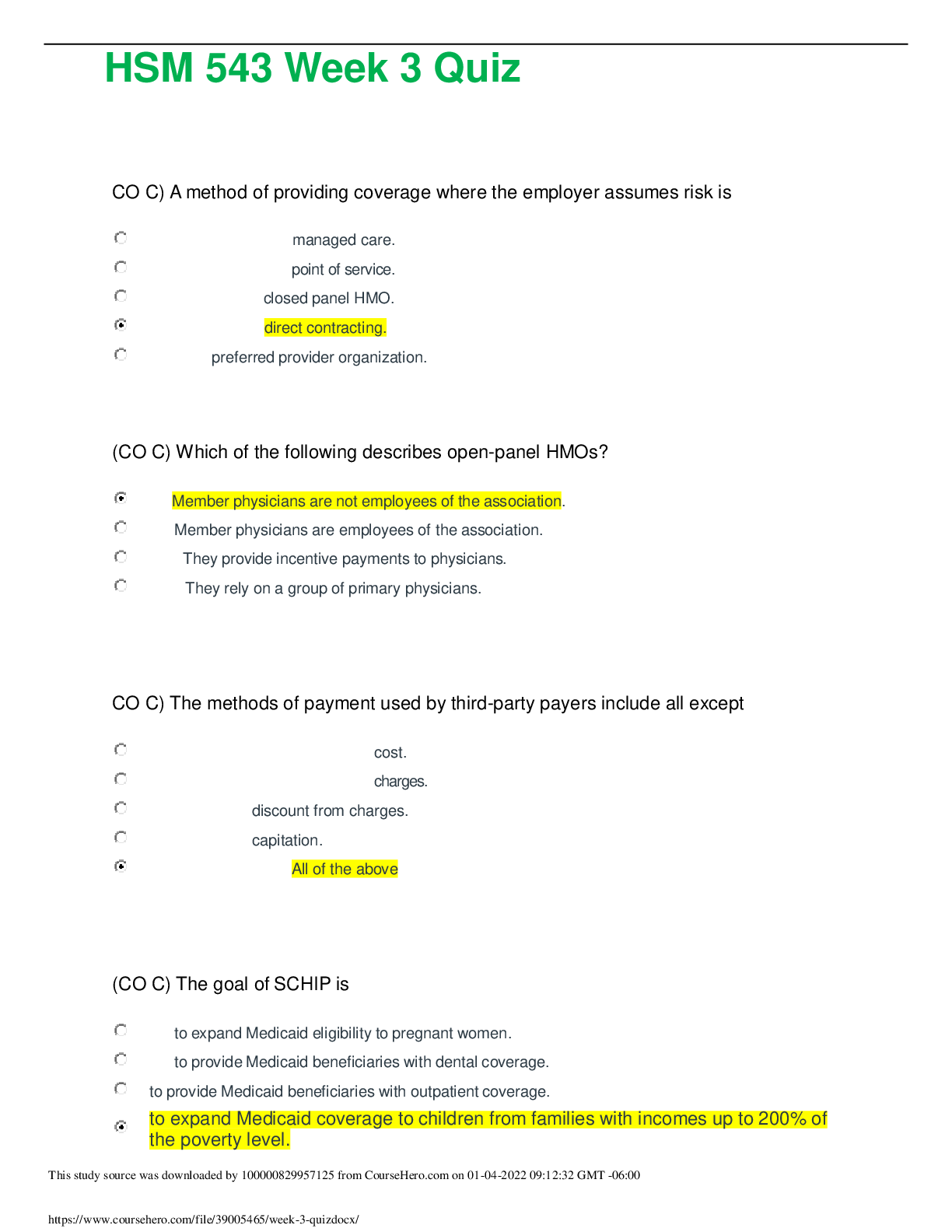
Reviews( 0 )
Document information
Connected school, study & course
About the document
Uploaded On
Oct 31, 2020
Number of pages
19
Written in
Additional information
This document has been written for:
Uploaded
Oct 31, 2020
Downloads
0
Views
57


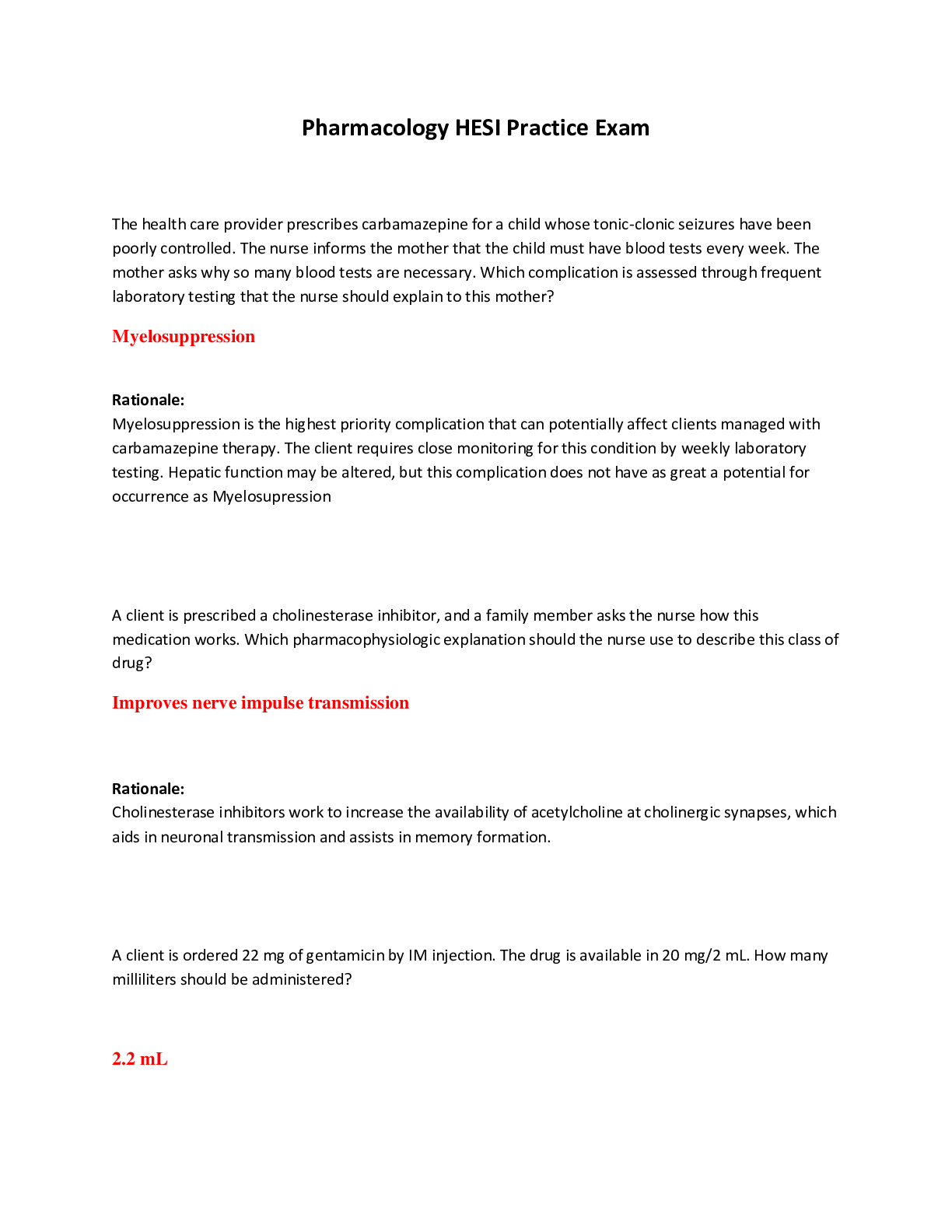
.png)
